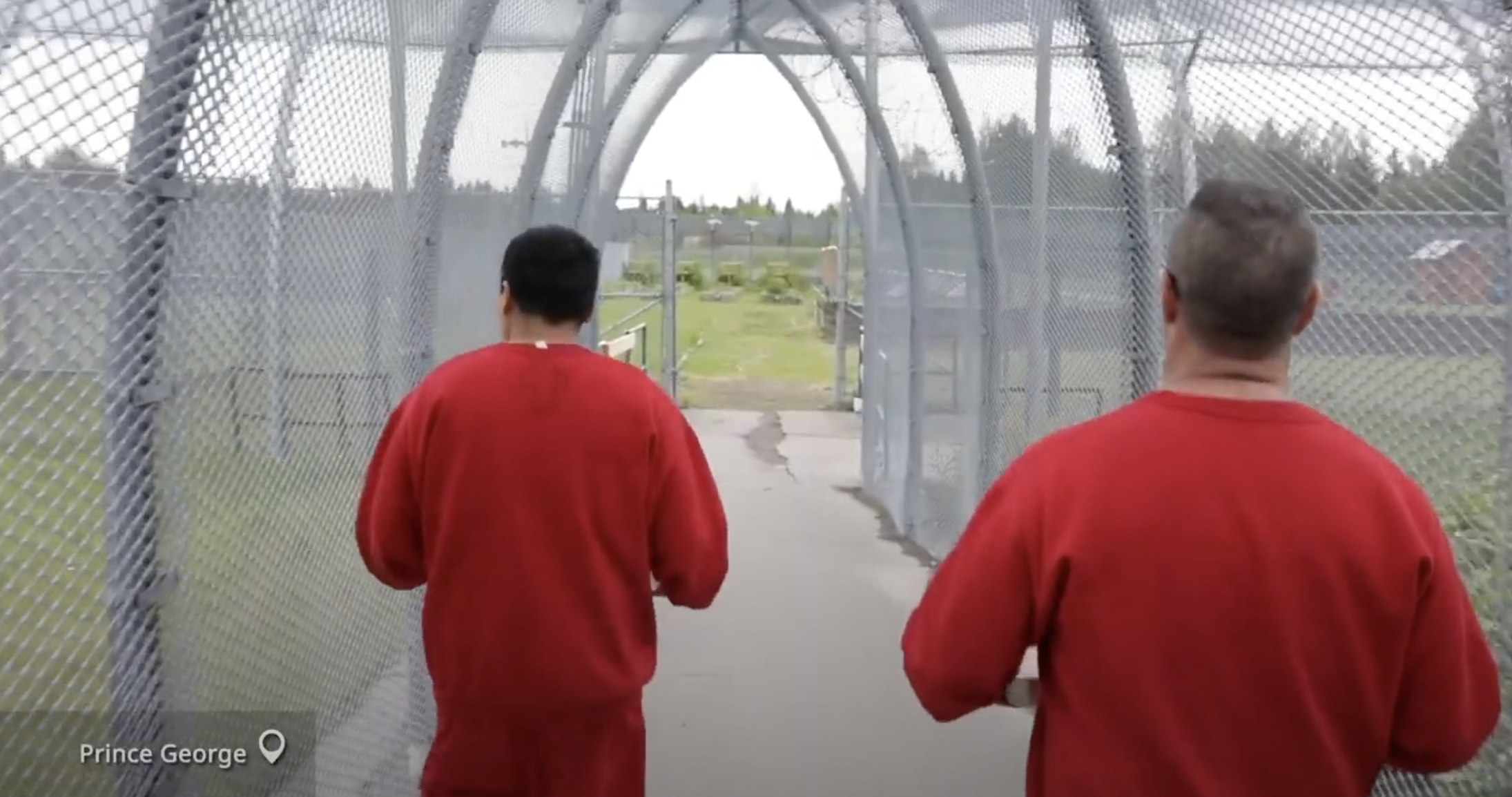Project Toadstool

CANNABIS CULTURE – 2 Genocidal Police Raids Against Both Hard Drug & Soft Drug Safer Supply Activists
On November 1st 2023, the VPD and the CSU raided 4 of Dana Larsen’s soft drug dispensaries – the cops called it “Project Toadstool” – the exact same day 21 drug policy experts from B.C. released a report calling for a safer supply of illegal drugs. One week before, the VPD raided the Drug Users Liberation Front (DULF) – activists distributing quality-control tested hard drugs. Coincidence? Or part of a genocidal master plan?
A deep dive into the recent raids by David Malmo-Levine.
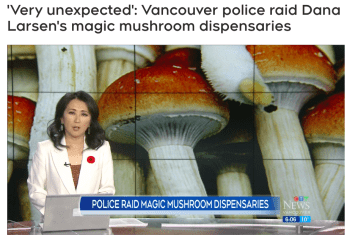
Image #1: https://bc.ctvnews.ca/very-unexpected-vancouver-police-raid-dana-larsen-s-magic-mushroom-dispensaries-1.6627117
“If you look at the Controlled Drugs and Substances Act, yes, we’re in violation of that. But there’s a Charter of Rights and a constitution in this country that overrides those laws and I believe at some point, the courts in Canada and the politicians will agree with me . . .”
- Dana Larsen, “‘Very unexpected’: Vancouver police raid Dana Larsen’s magic mushroom dispensaries,” CTV News, November 1st, 2023 (updated November 2nd, 2023) (1)

Image #2: Still image from Drugstore Cowboy, 1989
“Narcotics have been systematically scapegoated and demonized. The idea that anyone can use drugs and escape a horrible fate is anathema to these idiots. I predict, in the near future, right-wingers will use drug hysteria as a pretext to set up an international police apparatus . . . But I’m an old man, and I may not live to see a Final Solution of the drug problem.”
- William S. Burroughs, From Gus Van Sant’s Drugstore Cowboy, 1989 (2) adapted from manuscript by James Fogle Drugstore Cowboy: A Novel published 1990
November 1st, 2023
On November 1st, 2023, the Vancouver Police Department raided the Coca Leaf Café & Mushroom Dispensary on Hastings St. – founded by long-time drugpeace activist Dana Larsen – along with Larsen’s 2 other Mushroom (and other soft drug) Dispensaries – one on Broadway and one on Granville – while at the same time the Orwellianly-named “Community Safety Unit” raided Larsen’s Medicinal Cannabis Dispensary next door to the Coca Leaf Café.

Image #3: Coca Leaf Cafe staff phone camera

Image #4: https://dailyhive.com/vancouver/mushroom-dispensaries-raided-reopen
The Mushroom Dispensaries and Medicinal Cannabis Dispensary solve two types of drug problems. The first type of drug problem they solve is that they sell high-quality soft drugs people could use as a substitute for (or to help reduce their use of or help mitigate the withdrawal from) hard drugs. The second type of drug problem they solve is that part of the profits from the sale of these soft drugs fund the Get Your Drugs Tested (3) free service that help people identify contaminated, adulterated or mis-represented drugs. This service does “around 65% of all the drug testing in B.C.” (according to Larsen) – and tests both soft and hard drugs, whereas the government will only test hard drugs.
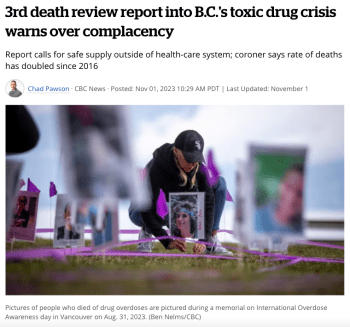
Image #5: https://www.cbc.ca/news/canada/british-columbia/death-panel-review-report-b-c-unregulated-toxic-deaths-safe-supply-needed-nov-2023-1.7015209
On the exact same day as the Mushroom/Cannabis dispensary raids, 21 experts in drug policy known as the “BC Coroners Service Death Review Panel” released a report titled An Urgent Response to a Continuing Crisis, which recommended (in recommendation #1):
“That the provincial Ministry of Mental Health and Addictions immediately begin taking steps to apply to the federal Minister of Health and Minister of Mental Health and Addictions for a class exemption to the Controlled Drugs and Substances Act (CDSA) to allow access without a prescription to the class of opioid and stimulant drugs, for people at risk of dying due to the toxicity of the drug supply in British Columbia.” (4)
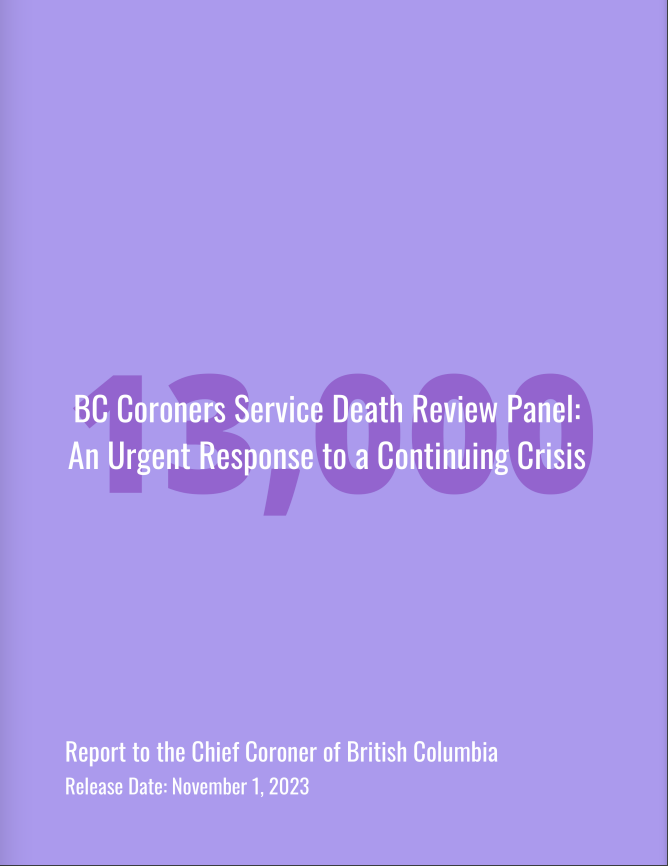
Image #6: https://www2.gov.bc.ca/assets/gov/birth-adoption-death-marriage-and-divorce/deaths/coroners-service/death-review-panel/an_urgent_response_to_a_continuing_crisis_report.pdf
Immediately before this section, the panel pointed out that
“. . . the primary driver of the drug crisis is the inherently toxic and volatile nature of the unregulated drug supply. Providing people at risk of dying with access to quality controlled, regulated alternatives is required to significantly impact the number of people dying.” (5)
October 25th, 2023
One week earlier, On October 25th 2023, the VPD raided DULF – the Drug User Liberation Front – a group supplying quality-controlled cocaine, heroin and meth:
“Vancouver police executed search warrants Wednesday at the office of the Drug User Liberation Front (DULF), an activist group that has admitted to distributing illegal drugs to substance users deemed at risk of overdosing. The Vancouver Police Department (VPD) said two people were arrested after raids at the DULF office at East Hastings and Columbia streets, and at two East Vancouver homes where suspected cocaine, heroin and methamphetamine were seized. The two individuals arrested were released Wednesday night and criminal charges, including possession for the purpose of trafficking, are being considered according to Insp. Phil Heard with the VPD’s Organized Crime Section. ‘While DULF’s actions were intended to reduce the harms caused by toxic drugs, we have always warned that anyone who violates the Criminal Code or the Controlled Drugs and Substances Act could face enforcement and criminal charges,’ said Heard. ‘This group has knowingly operated illegally in the Downtown Eastside and we have now taken action to stop it.’ DULF says its compassion club model allows drug users to receive up to 14 grams of cocaine, heroin or methamphetamine per week, with the substances tested for safety before sale. ‘These actions demonstrate the life-saving potential of a community-led response to the overdose crisis in Canada as a necessary alternative to prohibition and the unregulated drug supply,’ reads the DULF website.” (6)
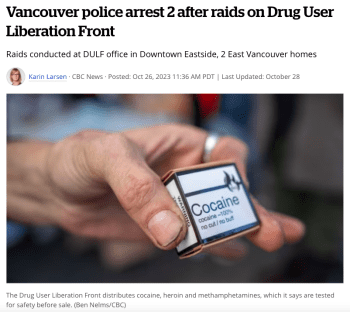
Image #7: https://www.cbc.ca/news/canada/british-columbia/drug-user-liberation-front-harm-reduction-vancouver-bc-police-arrests-1.7009019
Just to recap: Vancouver cops raided hard drug activists and soft drug activists providing quality-controlled alternatives to the unregulated, zero-quality control, lethal illegal drug market right before a report was going to be issued in Victoria (7) recommending that a quality-controlled supply of illegal drugs be allowed, in order to address an out-of-control global overdose crisis that isn’t being dealt with in any meaningful way by any government agency.
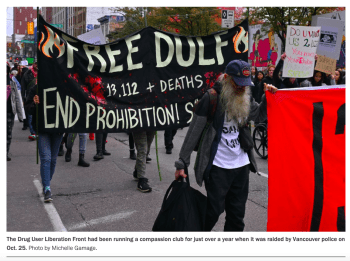
Image #8: https://thetyee.ca/News/2023/11/10/DULF-Compassion-Club-Safer-Drug-Supply-VPD-Raid-Death/
When asked by CBC radio reporter Gloria Macarenko what he thought of DULF, Michael Egilson, – chair of the B.C. Coroners Services’ death review panel – wouldn’t comment, and then expressed support for a program similar to – if not exactly like – the one DULF was involved with. (8) Same thing with B.C. Premier David Eby, who said the organization was breaking the law and had to be stopped, despite DULF having done “important, life-saving work.” (9)
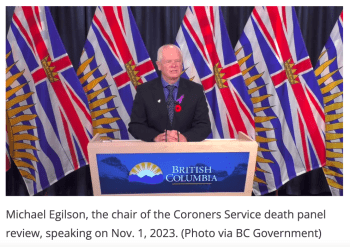
Image #9: https://www.radionl.com/2023/11/01/b-c-coroners-death-panel-recommends-issuing-drugs-without-prescription-to-stop-ods/
BC Government officials seem to all be caught in a contradiction: “We must do anything and everything to stop the massive, ever-growing number of needless deaths from stupid drug laws – anything and everything aside from disobeying stupid drug laws.”
Studies And Evidence
There is a lot of evidence that quality-controlled hard drugs – sold at cost – can reduce or eliminate a majority of the problems associated with hard drug use. There is also a lot of evidence that mushrooms, kratom, coca and other soft drugs can be used as substitutes for hard drugs or to reduce/eliminate hard drug use.
Heroin Assisted Therapy
Regarding the evidence of prescription heroin being a successful way to reduce hard drug problems, there is no better example than the prescription heroin programs in Merseyside (the area around Liverpool) and Wirral (a subsection of Merseyside), in England. Prescription morphine and heroin had been widely available in all of England from the 1920s to the 1960s, with no negative consequences. (10)
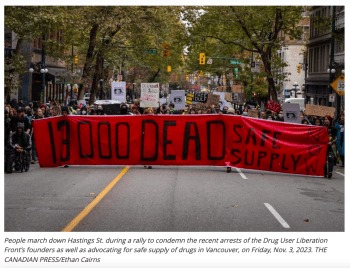
Image #10: https://www.stalbertgazette.com/national-news/safe-supply-supporters-march-after-arrests-of-vancouver-drug-activists-7783702
While drug use expanded in the UK in the 1960s and 1970s leading to a crackdown in most places, heroin prescription continued in Merseyside, and data began to be collected in the 1980s regarding the results of this experiment in medical autonomy:
“The outcomes of this program were stunning. By 1989, compared with rates of HIV infection among intravenous drug users in New York and London of 70% and 60%, respectively, Liverpool’s rate was 0.01%. An unintended outcome was the disappearance of the black market in heroin in Merseyside. The market had dried up because of lack of demand. Heroin simply couldn’t be bought on the street in Liverpool and the surrounding county.” (11)
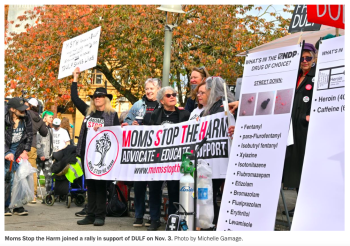
Image #11: https://thetyee.ca/News/2023/11/10/DULF-Compassion-Club-Safer-Drug-Supply-VPD-Raid-Death/
A 2003 study found many benefits of prescription heroin:
“. . . prescribing heroin is feasible in specialist clinical settings, that it succeeds in retaining people in treatment and that there are health and social gains. Patients improve in most areas – physical and mental health are noticeably better, illicit drug use and crime are reduced, and employment increases.” (12)
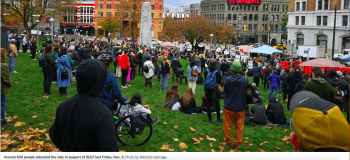
Image #12: https://thetyee.ca/News/2023/11/10/DULF-Compassion-Club-Safer-Drug-Supply-VPD-Raid-Death/
British drugpeace activists point to staggering statistics associated with the Merseyside heroin-assisted treatment (HAT) program: Zero overdose deaths, zero infections, and a 93% fall in theft and burglary. (13) Heroin prescription was still available in some places in Merseyside as of the year 2000, (14) but in spite of experts recommending expanding HAT programs, (15) funding in England was cut in 2015 and many of the HAT programs were shut down. (16)
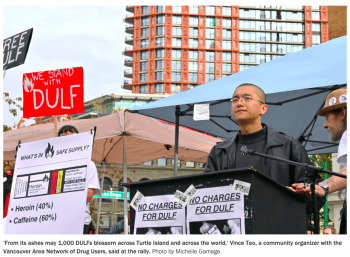
Image #13: https://thetyee.ca/News/2023/11/10/DULF-Compassion-Club-Safer-Drug-Supply-VPD-Raid-Death/
Evidence exists regarding the prescription heroin program in Wirral – a subsection of Merseyside – which got lots of attention and was shut down – but not because it wasn’t working, but rather because it was working:
“The first people to notice an effect were the local police. Inspector Michael Lofts studied 142 heroin and cocaine addicts in the area, and he found there was a 93 per cent drop in theft and burglary. ‘You could see them transform in front of your own eyes,’ Lofts told a newspaper, amazed. ‘They came in in outrageous condition, stealing daily to pay for illegal drugs; and became, most of them, very amiable, reasonable law-abiding people.’ He said elsewhere: ‘Since the clinics opened, the street heroin dealer has slowly but surely abandoned the streets of Warrington and Widnes.’ One day a young mother called Julia Scott came into Dr Marks’s surgery and explained she had been working as a prostitute to support her habit. He wrote her a prescription, and she stopped sex work that day. And something nobody predicted took place. The number of heroin addicts in the area actually fell. Research published by Dr Marks in the Proceedings of the Royal College of Physicians of Edinburgh compared Widnes, which had a heroin clinic, to the very similar Liverpool borough of Bootle, which didn’t — and found Widnes had 12 times fewer addicts. But why would prescribing heroin to addicts mean that fewer people became addicts? Dr Russell Newcombe, working out of John Marks’s clinic, told me what he believes is the explanation. Imagine you are a street heroin addict. You have to raise a large sum of money every day for your habit: £100 a day for heroin at that time in the Wirral. How are you going to get it? You can rob. You can prostitute. But there is another way, and it’s a lot less unpleasant. You can buy your drugs, take what you need, and then cut the rest with talcum powder and sell it on to other people. But to do that, you need to persuade somebody else to take the drugs too. You need to become a salesman, promoting the experience. So heroin under prohibition becomes, in effect, a pyramid-selling scheme. ‘Insurance companies would love to have salesmen like drug addicts’ — i.e. with that level of motivation — Dr Marks explains. Prescription kills the scheme. You don’t have to sell smack to get smack. When Dr Marks’s experiment began to attract tabloid attention — and bring diplomatic pressure from the US government — the British government panicked and shut it down. The results came quickly. In all the time Dr Marks was prescribing, from 1982 to 1995, he never had a drug-related death among his patients. After the closure, of the 450 patients Marks prescribed to, 20 were dead within six months, and 41 were dead within two years. More lost limbs and caught potentially lethal diseases. Both Sydney, the Liverpool docker, and Julia, the young mother who had given up prostitution, died. Dr Marks found he was blacklisted within his own country. He ended up literally at the other side of the earth, in Gisborne, the farthest corner of New Zealand, the place from which he told me his side of the story by telephone. One day, the Royal Astronomical Society asked him to play Galileo at an open day, and he had to play-act being burnt at the stake. When I expressed frustration at his fate, he said to me, ‘Whatever gave you the idea folk in authority operate according to reason? Your trouble is you’re being rational.’ Today, Britain has more than 250,000 people using illegal opiates — and Dr Marks’s experiment, in the drizzle and hope of the Wirral, has been written out of history.” (17)

Image #14: https://www.independent.co.uk/news/uk/home-news/heroin-addiction-diamorphine-treatment-british-system-hat-leap-harm-reduction-a9061556.html
Fortunately, in spite of some of the HAT programs ending in the UK, some good came out of it. The UK experiments in HAT led to similar programs in Switzerland, Germany and the Netherlands:
“In the 1980s and early 1990s, Dr John Marks ran heroin-prescribing clinics in Liverpool, Widnes and Warrington that were highly controversial. Because of the lack of large-scale trials, only anecdotal evidence existed as to the efficacy of the treatment. This changed in 1994 when Switzerland, faced with one of the largest open drug scenes in Europe at the time, started large-scale trials on the potential use of diamorphine as a maintenance drug. They proved diamorphine to be a viable maintenance drug which has shown equal or better rates of success than methadone in terms of assisting long-term users establish stable, crime-free lives. These results encouraged countries like Germany and the Netherlands to conduct their own trials and finally to include heroin-assisted treatment fully as a part of the national health system in 2009. In Switzerland, heroin has been made available under supervision to addicts since around 1994. Several studies have been conducted between 1994-1996.” (18)
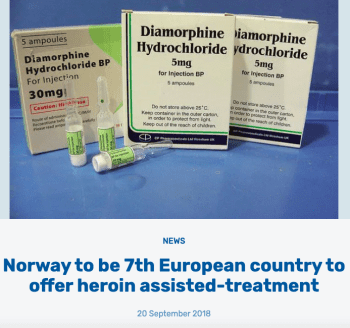
Image #15: https://idpc.net/news/2018/09/norway-to-be-7th-european-country-to-offer-heroin-assisted-treatment
Since 2011, HAT has been available to a very limited number of people in Vancouver, with similar “zero overdose deaths” statistics arising:
“Since 2011, the clinic has seen about 200 patients. None of them, MacDonald said, have died under the clinic’s supervision. In fact, as far as he can tell, no one has died at any prescription heroin facility due to an overdose — not in Canada, Switzerland, Germany, or the Netherlands. ‘So relatively safe,’ I said. ‘Yes,’ MacDonald said. ‘Well, not even relatively. It’s safe.’” (19)
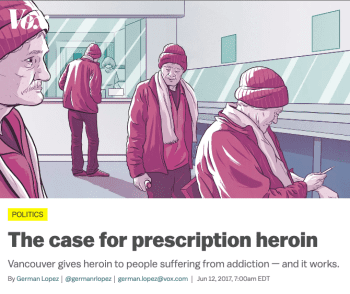
Image #16: https://www.vox.com/policy-and-politics/2017/6/12/15301458/canada-prescription-heroin-opioid-addiction
The problem is, the government won’t expand the program beyond the 200 or so very lucky participants. Which is where DULF came in. They expanded the government program by 47 (at last count) more individuals, with “zero overdose deaths” from DULF’s substances and “a 32% decrease in overdoses requiring naloxone administration (ODN) and 35% reduction in all overdoses” that don’t involve deaths. (20)

Image #17: https://thetyee.ca/News/2023/11/10/DULF-Compassion-Club-Safer-Drug-Supply-VPD-Raid-Death/
Just like the shutting down of the Merseyside Hat programs, the DULF raid can be seen to be a result of – not the harm done by DULF to the community – but the success of the DULF program and the looming changes in drug policy that the successful program represents.

Image #18: Bob High & David Malmo-Levine, from Skid Row Comix (unpublished), 2019
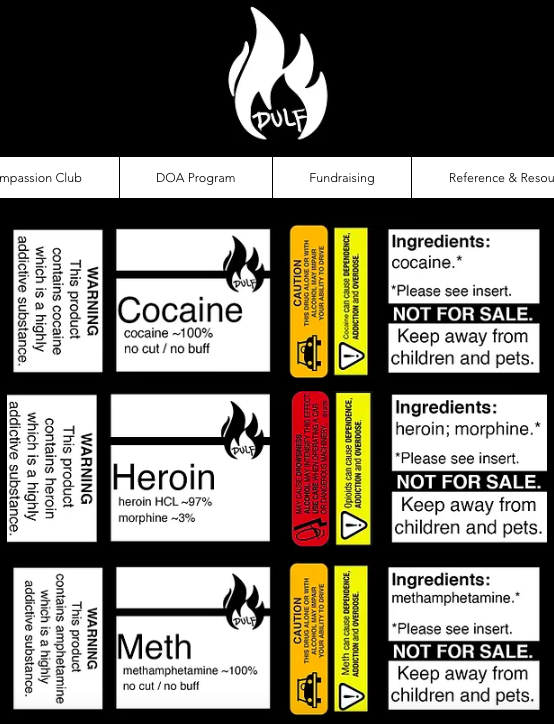
Image #19: https://www.dulf.ca/
The medical establishment and the political establishment and the justice and police establishment all have a vested interest in things staying the way they are. For it is the corruption that comes with drug prohibition – and the profits that come with the medical monopoly – that the establishment wants to perpetuate forever, rather than see it all vanish as a result of the end of drug prohibition.
Soft Drug Substitution
The Coca Leaf Café and Mushroom Dispensary (and the other two Mushroom Dispensaries) offer many different soft drugs, some of which have been involved in addiction treatment research, including coca, magic mushrooms, kratom, ayahuasca, peyote and LSD.
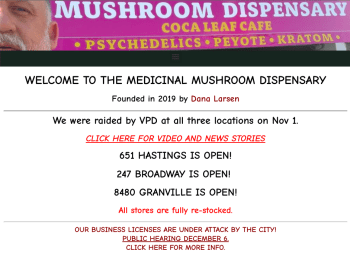
Image #20: https://mushroomdispensary.com/
On the Coca Leaf Café’s website (21) one can find a link to a study that found that the use of coca leaf can help an individual reduce their use of cocaine. (22)

Image #21: https://cocaleafcafe.com/about-the-cafe/
Recent research has indicated magic mushrooms may be helpful “with smoking, other addictions, and mental-health problems.” (23)

Image #22: “Restocked showcase at Coca Leaf Café.” Photo by author, November 6th, 2023.
Kratom has been the subject of studies related to substitution for opioids, in at least one (always problematic) animal study (24) and also at least one (severely small subject population) human study. (25) One literature review from 2018 regarding kratom as an opioid substitute was optimistic:
“Findings indicate kratom’s potential as a harm reduction tool, most notably as a substitute for opioids among people who are addicted. Kratom also enhances mood and relieves anxiety among many users. For many, kratom’s negative mental health effects – primarily withdrawal symptoms – appear to be mild relative to those of opioids. For some users, however, withdrawal is highly uncomfortable and maintaining abstinence becomes difficult.” (26)
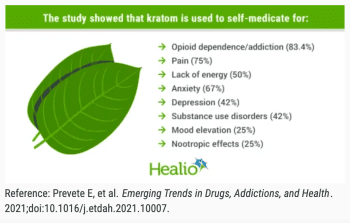
Image #23: https://www.healio.com/news/primary-care/20210423/most-people-use-kratom-to-selfmanage-opioid-addiction
One of the authors of this review summarized their findings this way:
“. . . data across cultures indicated that kratom has a legitimate role to play in mitigating harms associated with opioid dependence. The bulk of the available research supports kratom’s benefits as a milder, less addictive and less-dangerous substance than opioids, and one that appears far less likely to cause fatal overdose.” (27)
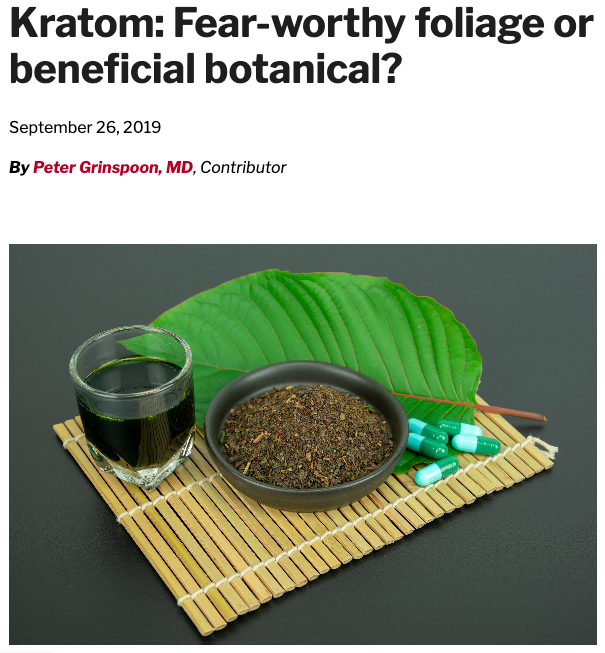
Image #24: https://www.health.harvard.edu/blog/kratom-fear-worthy-foliage-or-beneficial-botanical-2019080717466
Another literature review of kratom as an opioid substitute from 2021 revealed that
“For generations, indigenous peoples in Southeast Asia have used fresh kratom leaves (either unprocessed or brewed into teas or other decoctions) as a mild stimulant to stave off fatigue, or as an opioid substitute to treat pain or opioid use disorder (Vicknasingam et al., 2010; Singh et al., 2016). . . . In the United States, kratom products are used extensively for the self-management of pain, opioid use disorder and depression (Swogger et al., 2015; Grundmann, 2017; Swogger and Walsh, 2018; Schimmel et al., 2021).” (28)

Image #25: Takiwasi Center Research Department https://www.youtube.com/watch?v=4sA6Cf3VNlQ&t=3s
An addiction treatment center named “Takiwasi” (“The Singing House” in Quechua language) is an NGO located in the city of Tarapoto, in the Upper Peruvian Amazon region. On their website they have collected over two dozen studies involving ayahuasca ceremonies as a treatment for drug addiction. (29) In one of these reports, a summary of the research on the use of soft drugs to treat addiction involved the following herbal medicines and their studies:
“A brief review of the literature indicates to date that various psychoactive substances have been used as a tool to overcome addiction: • Ayahuasca (Cemin & al 2000;. Labate & al. 2010; Labigalini Jr., 1998; McKenna 2004; Moir 1998; Ricciardi 2008; Santos & al. 2006); • Cannabis – Cannabis sativa (Labigalini Jr. & Roberts 1997; Labate & al. 2010); • Peyotl – Lophophorawilliansii, mexican cactus rich in mescalin (Halpern & al., 2005). . .” (30)
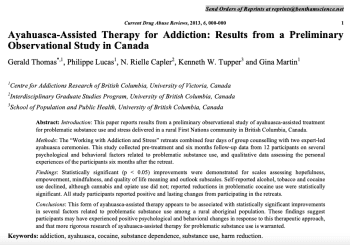
Image #26: https://maps.org/research-archive/ayahuasca/Thomas_et_al_CDAR.pdf
Another overview of hallucinogens in the treatment of addictions cites even more evidence of the efficacy of such drugs:
“Observational studies have suggested that sacramental use of plant materials containing classic hallucinogens (peyote, containing mescaline, or ayahuasca, containing DMT) suggests that these practices are associated with decreased disordered use of substances and few if any detrimental effects (Albaugh and Anderson, 1974b; Barbosa et al., 2012; Doering-Silveira et al., 2005; Fabregas et al., 2010; Garrity, 2000; Halpern et al., 2005; Halpern et al., 2008; Kunitz and Levy, 1994; Lu et al., 2009; Roy, 1973).” (31)
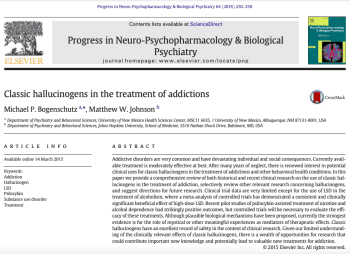
Image #27: https://soultribes.org/wp-content/uploads/2023/06/Bogenschutz2016-Classic_hallucinogens_in_the_treatment_of_addictions.pdf
Other studies have revealed the explosion in psychedelic-based addiction therapy research in recent years:
“Recently, serotonergic hallucinogens (here also referred to as psychedelics), such as psilocybin, lysergic acid diethylamide (LSD), or N,N-dimethyltryptamine (DMT), have shown great promise in reducing symptoms of substance addictions and mood disorders, as indicated by a vast body of research and reviews (Dos Santos et al., 2018; Romeo et al., 2021; Bogenschutz et al., 2022; Calleja-Conde et al., 2022; Jones et al., 2022; Mendes et al., 2022; van der Meer et al., 2023).” (32)
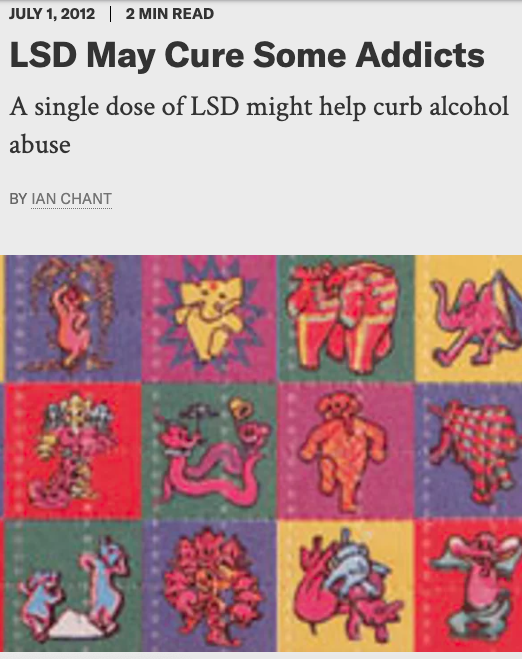
Image #28: https://www.scientificamerican.com/article/lsd-may-cure-some-addicts/
LSD is also often mentioned as having potential in addiction therapy research, (33) especially in comprehensive reviews of hallucinogen addiction-therapy efficacy and in relation to cocaine and opioid dependence treatment. (34)

Image #29: https://norml.org/marijuana/fact-sheets/relationship-between-marijuana-and-opioids/
As for cannabis, the evidence is familiar to anyone who’s been paying attention to trends in cannabis medicine. (35) NORML has prepared a large list of studies regarding the relationship between cannabis and opioids. (36)
If these drugs were better researched and their potential for addiction treatment therapy became better understood, many “addiction treatment specialists” that focus on synthetic drug treatment and group therapy would probably be out of work (to be replaced with farmers, herbalists and effective and affordable herbal medicines), and the public would immediately realize how much of a joke this war on these beneficial herbal and non-proprietary medicines actually is.
Raid Reasons And Raid Pretexts, Part 1
The raids served many purposes, not least of which was to steal headlines away from an Overdose Crisis report released the same day. Larsen himself speculated that the raids involved local and regional politicians trying to score points from the conservative wing of their base. Law enforcement officials in Vancouver were no doubt attempting to please their true clients – the rich and powerful, which include the recently-minted corporate pot cartel and the emerging corporate shroom cartel – both of whom obviously want their legacy competition eliminated.
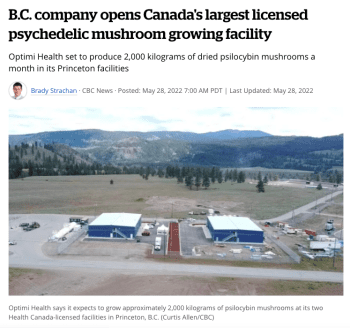
Image #30: https://www.cbc.ca/news/canada/british-columbia/psychedelic-mushrooms-psilocybin-health-canada-clinical-trials-1.6469310
The rich and the powerful also include the corporations who profit from legal sales of stimulants and opiates – and the CIA and similar groups that profit from smuggling illegal stimulants and opiates. Many powerful groups want to see illegal drugs stay illegal, or at the very least they want to see the prohibitions that can’t be maintained transformed into cartels instead.
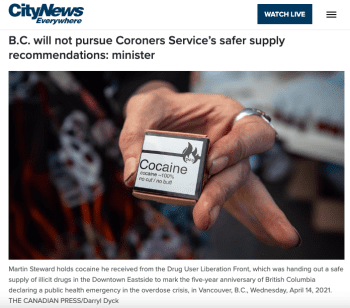
Image #31: https://vancouver.citynews.ca/2023/11/01/bc-coroners-service-recommendations-toxic-drug-supply/
There’s another reason aside from corporate and clandestine drug profits that the raids were carried out: the genocide of the medically autonomous. Not necessarily the killing of drug users/growers/dealers, but rather more specifically the elimination of the characteristic within human beings that allow some of them to make decisions on drug use and drug sales and drug production based on considerations other than legality. Genocide is a pretty heavy concept, so I will address it at the end of the article, after I have fully reviewed the actions and the reasons provided by the powers that be for the raids.
November 1st, 2023
The day began for me – evening shift supervisor at the Coca Leaf Café – like most any other. I woke up around 11AM and reached for my phone to check the café group chat to see if there was any concern raised or problem mentioned that I could help to troubleshoot.
“Cops at Broadway.”
“Police at Granville.”
“Hastings too?”
“Oh oh.” I thought. Here we go.
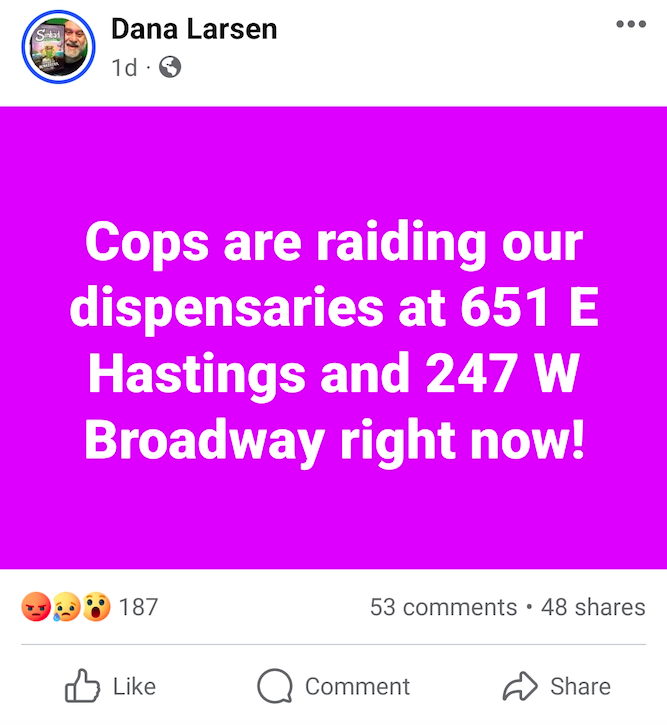
Image #32: Dana Larsen, Facebook, circa 11:30 AM, November 1st, 2023
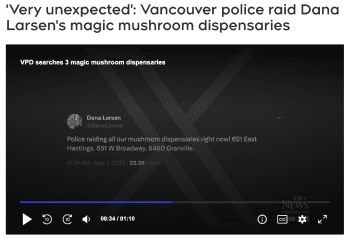
Image #33: https://bc.ctvnews.ca/very-unexpected-vancouver-police-raid-dana-larsen-s-magic-mushroom-dispensaries-1.6627117
I was told by Cindy the manager at the Café to not go down to the Café to protest, so I stayed home and gathered media from the raid – the news media, the social media and the photos and videos from people’s cell phones. The following are some highlights from that:
“Police spokesperson Sgt. Steve Addison said the sudden enforcement should serve as a warning to other dispensaries operating illegally in the city. ‘This relates to an ongoing investigation into what we believe is the illegal purchase and sale of psychedelic drugs, psilocybin and other products,’ Addison told CTV News. ‘If you do violate the Criminal Code and the Controlled Drugs and Substances Act… you could face arrest and charges.’ Larsen has been battling the city over his dispensaries for months, with officials accusing him of violating the terms of his business licences. There is an ongoing effort to have those licences taken away, with a court hearing pending. ‘I thought that the city would let the bureaucracy deal with us like they have with cannabis dispensaries in the past,’ Larsen said in his Facebook video. ‘We’ve been here at this location for three years operating very openly and transparently.’ Prior to cannabis legalization, officials and police largely turned a blind eye to cannabis dispensaries, which at one point outnumbered the number of Starbucks and Tim Hortons locations in the city. Addison said the timing of Wednesday’s raid came down to police priorities and resources. ‘We will always prioritize organized crime, dangerous offenders, gangsters, people who are producing and trafficking the most harmful opioids such as fentanyl, heroin, crack cocaine,’ he said. Larsen has used revenue from his dispensaries to fund a drug testing project out of his East Hastings location since 2019, and boasted Wednesday at having analyzed more than 60,000 samples. ‘I don’t think this raid is a good use of resources,’ he said in his live stream. ‘But you know, sometimes it takes a raid to make change happen, to get people worked up and thinking about whether they want to have mushroom dispensaries in their city, whether they want Vancouver to continue to be a leader in the progressive drug movement.’” (37)
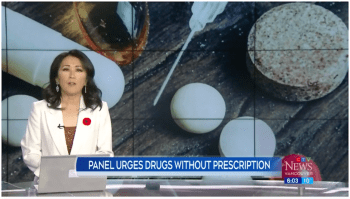
Image #34: “Panel urges B.C. to offer safe drugs without prescription,” CTV Vancouver, Nov. 1st, 2023
https://www.youtube.com/watch?v=D4t9qNrbsLg
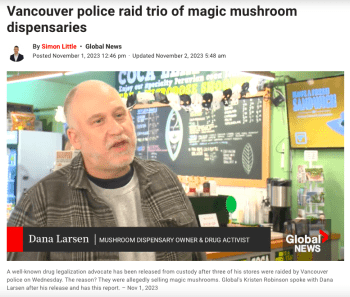
Image #35: https://globalnews.ca/news/10064387/mushroom-raids-vancouver/
I
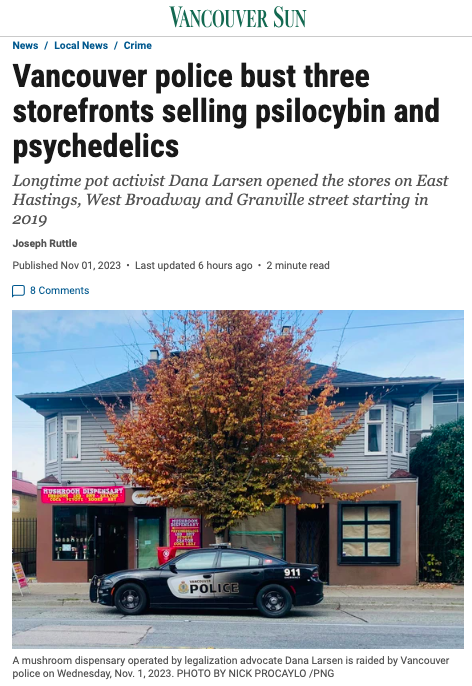
mage #36: https://vancouversun.com/news/local-news/vancouver-police-bust-storefronts-selling-psilocybin-mushrooms-psychedelics

Image #37: https://vancouversun.com/news/local-news/vancouver-police-bust-storefronts-selling-psilocybin-mushrooms-psychedelics
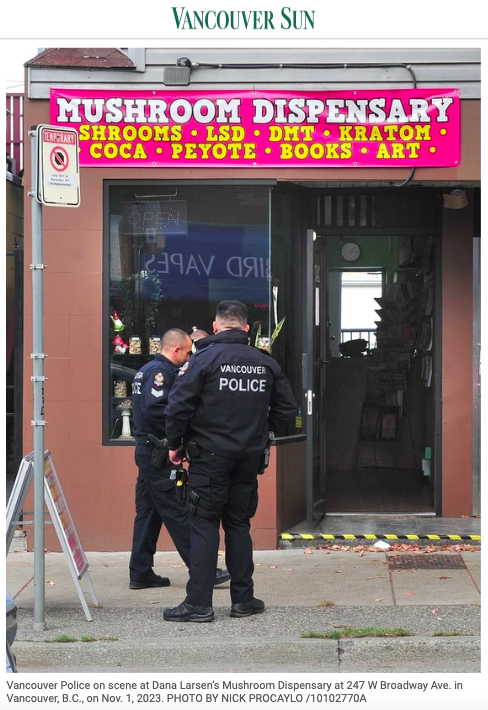
Image #38: https://vancouversun.com/news/local-news/vancouver-police-bust-storefronts-selling-psilocybin-mushrooms-psychedelics
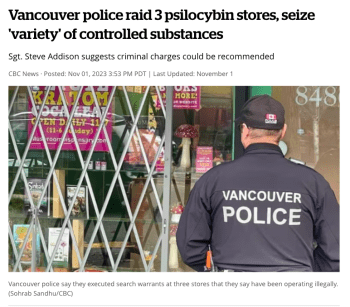
Image #39: https://www.cbc.ca/news/canada/british-columbia/vancouver-police-raid-3-psilocybin-stores-seize-variety-of-controlled-substances-1.7015692
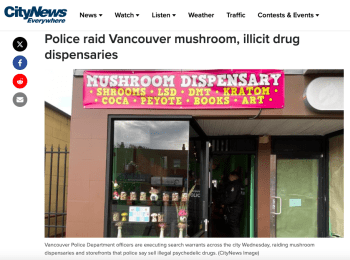
Image #40: https://vancouver.citynews.ca/2023/11/01/vancouver-mushroom-dispensary-raids-police/

Image #41: https://vancouver.citynews.ca/2023/11/01/vancouver-mushroom-dispensary-drug/
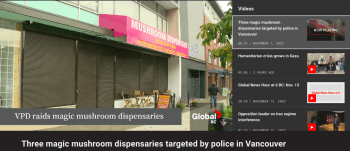
Image #42: https://globalnews.ca/video/10064981/three-magic-mushroom-dispensaries-targeted-by-police-in-vancouver

Image #43: https://www.vancouverisawesome.com/local-news/police-raid-psychedelics-mushroom-dispensaries-across-vancouver-7770694
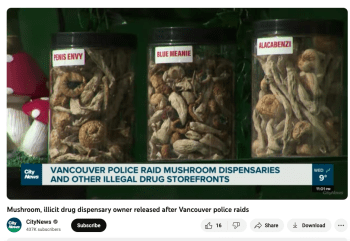
Image #44: “Mushroom, illicit drug dispensary owner released after Vancouver police raids,” CityNews https://www.youtube.com/watch?v=uzEbKYUQ2rM
Dana told me later on that the cops kept trying to interrogate him and get him to incriminate himself. He resisted the temptation to engage with them and kept repeating “I just want to go back to my cell.” He was eventually let out – after seven hours of listening to other prisoners go through withdrawal symptoms or experience other medical problems – (so far) without any charges against him.
November 2nd, 2023
“‘We have always been clear that our biggest priority is to target organized criminals who are manufacturing, producing, and profiting off the harmful opioids that fuel the overdose crisis,’ Vancouver Police Department spokesperson Sergeant Steve Addison said this week. ‘While this remains the primary focus of our drug enforcement efforts, our recent successes in a number of organized crime investigations … have allowed us to turn some attention to other criminal enterprises.’ . . . Mike Farnworth, B.C.’s Solicitor-General and Minister of Public Safety, did not immediately respond to a request to comment Thursday, but has previously said mushroom dispensaries should be denied business licences of any kind and be shut down immediately. The federal Liberal government has repeatedly said it is not interested in legalizing more drugs after cannabis. Meanwhile, Ottawa has heavily restricted access to psilocybin, with only two hundred or so patients and health care workers being granted access over the past three years. These patients have often taken the drug as a way to deal with anxiety and depression brought on by a terminal illness. Health Canada has stated that magic mushrooms do not usually lead to addiction, but a user may experience anxiety, fear, nausea and muscle twitches when they take the drug. Since last year, the department has also greenlit 21 clinical trials investigating psilocybin. . . . Sgt. Addison rejected the allegation his department was influenced by city hall, stating it determines its own investigative priorities ‘and does not take direction from outside agencies or other levels of government.’” (38)
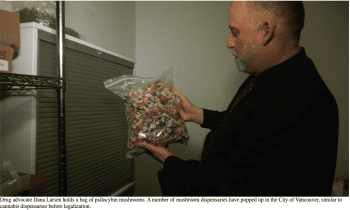
Image #45: https://bc.ctvnews.ca/very-unexpected-vancouver-police-raid-dana-larsen-s-magic-mushroom-dispensaries-1.6627117

Image #46: Nearly empty showcase. Nov. 2nd, 2023. Photo by David Malmo-Levine

Image #47: Empty cash register. Nov. 2nd, 2023. Photo by David Malmo-Levine

Image #48: All the drugs were stolen. Nov. 2nd, 2023. Photo by David Malmo-Levine

Image #49: Where some stolen drugs used to be. Nov. 2nd, 2023. Photo by David Malmo-Levine

Image #50: Pounds of shrooms – gone. Nov. 2nd, 2023. Photo by David Malmo-Levine
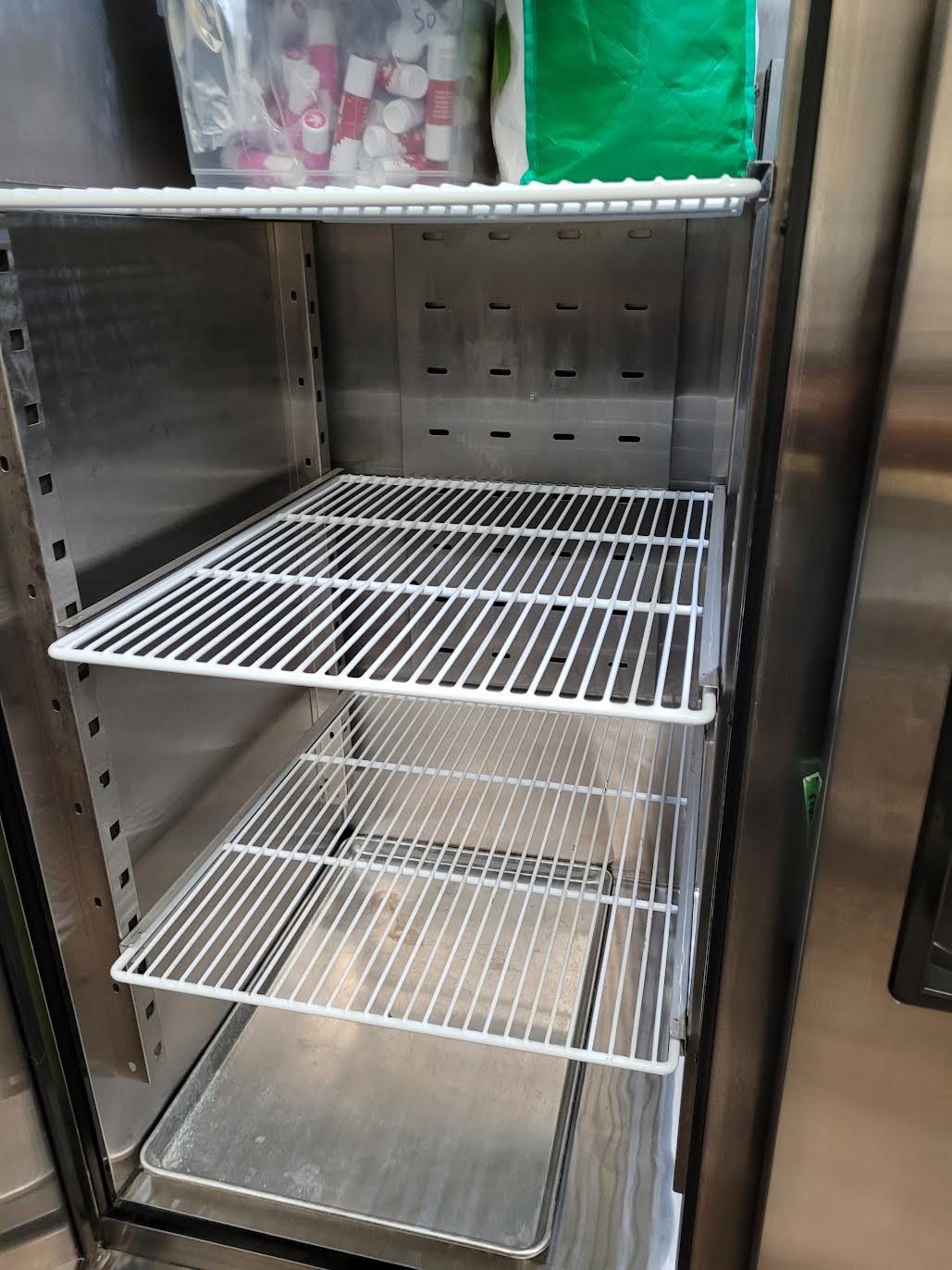
Image #51: A fridge full of LSD – gone. Nov. 2nd, 2023. Photo by David Malmo-Levine
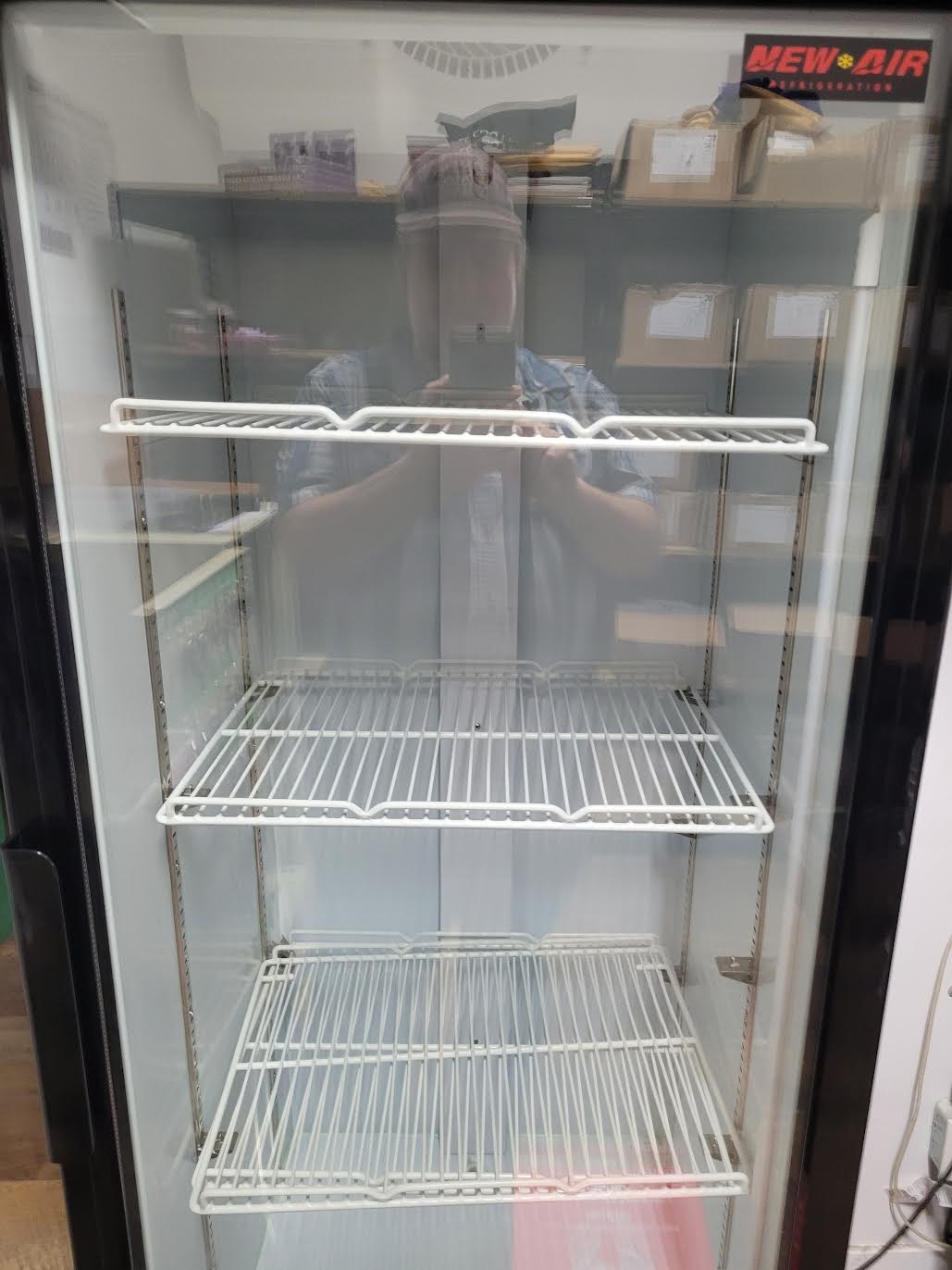
Image #52: All our chocolate shrooms – gone. Nov. 2nd, 2023. Photo by David Malmo-Levine

Image #53: Shrooms and coca powder – gone. Nov. 2nd, 2023. Photo by David Malmo-Levine

Image #54: Cops missed a box of Mushies! Nov. 2nd, 2023. Photo by David Malmo-Levine
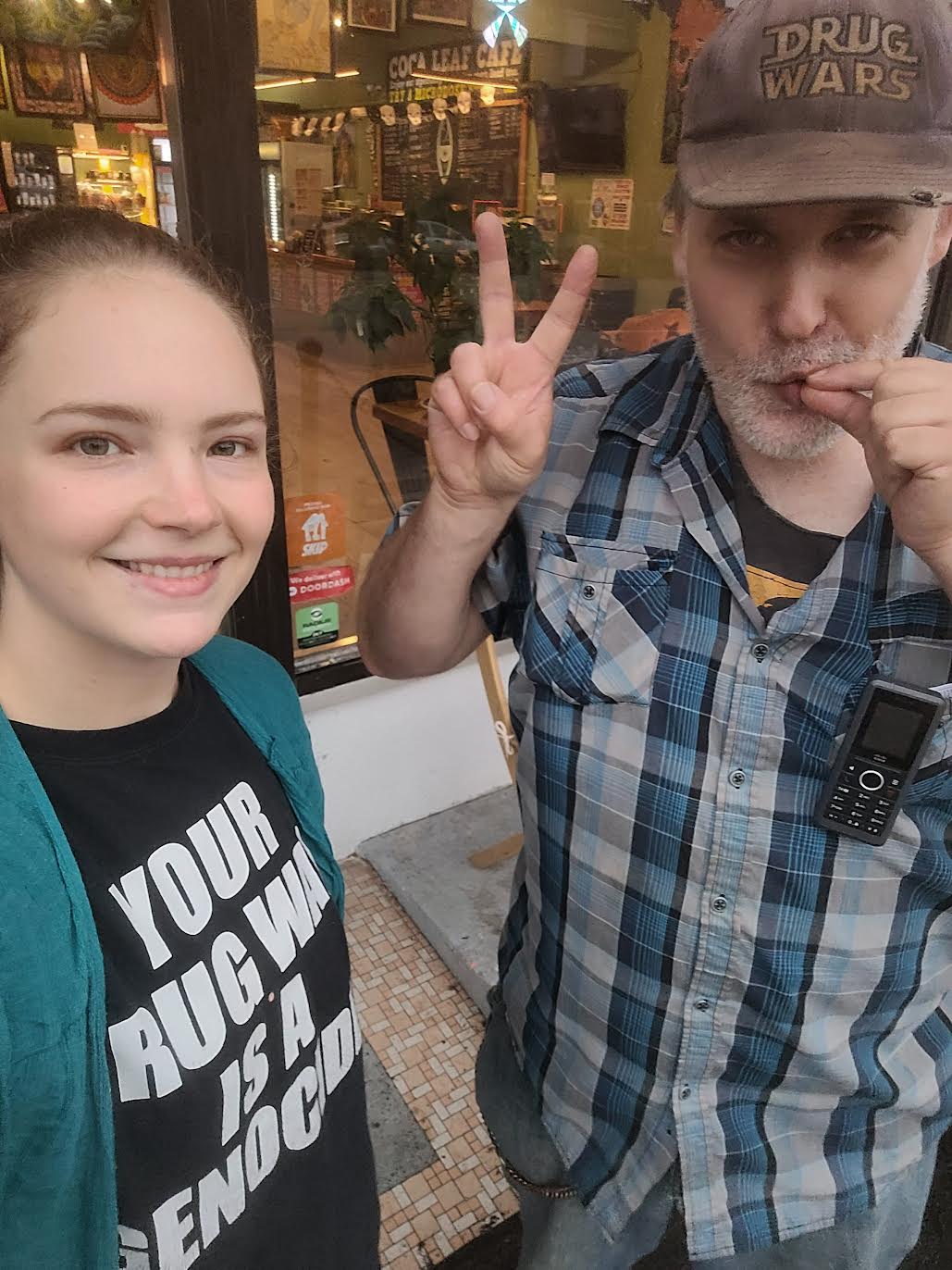
Image #55: Back open the next morning! Nov. 2nd, 2023. Photo by David Malmo-Levine
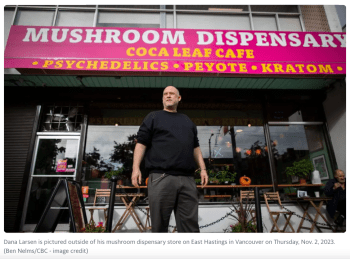
Image #56: https://ca.news.yahoo.com/vancouver-magic-mushroom-stores-reopening-002600794.html
November 3rd, 2023

Image #57: Facebook.com
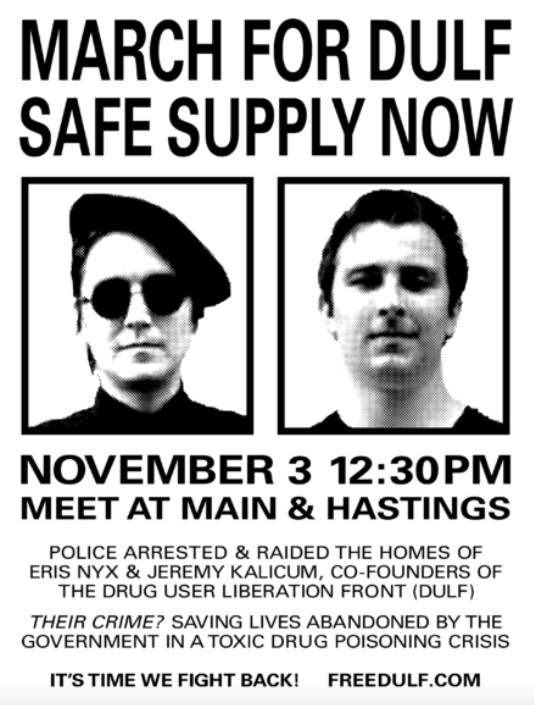
Image #58: https://themainlander.com/2023/10/30/dulf-saves-lives-solidarity-links/
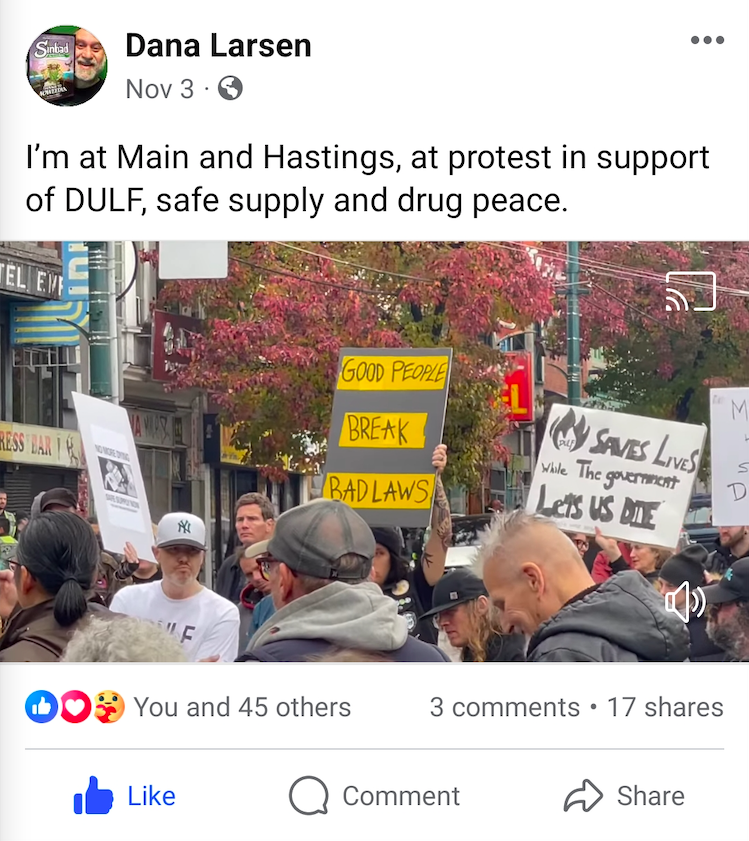
Image #59: Facebook.com
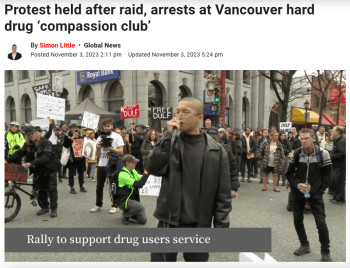
Image #60: https://globalnews.ca/news/10069801/dulf-protest-arrests-compassion-club-drugs/
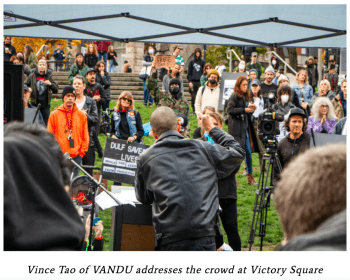
Image #61: https://filtermag.org/vancouver-rally-dulf-compassion-club/

Image #62: https://globalnews.ca/news/10069801/dulf-protest-arrests-compassion-club-drugs/
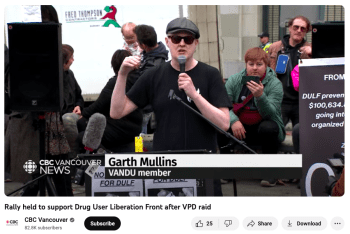
Image #63: “Rally held to support Drug User Liberation Front after VPD raid,” CBC Vancouver https://www.youtube.com/watch?v=qZZOrXFo0Ns
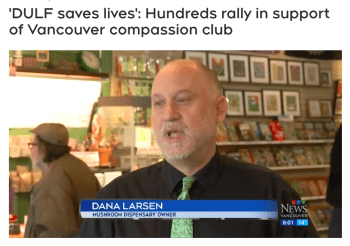
Image #64: https://bc.ctvnews.ca/dulf-saves-lives-hundreds-rally-in-support-of-vancouver-compassion-club-1.6630883
November 5th, 2023
“Olaf Pettersen regularly visits the Medicinal Mushroom Dispensary’s main storefront on East Hastings to manage spinal pain from quadriplegia and advanced osteoporosis. ‘Doses of the drug help reduce my spasms. Without these sorts of storefronts, I don’t know where people like me would find the substances,’ he said.
The 55-year-old was stunned to hear this week Vancouver police raided the 651 East Hastings St. store he frequents, as well as two other locations that sell magic mushrooms, as part of a stated effort to crack down on the sale of illegal substances in the city. ‘It’s ridiculous,’ Pettersen said. ‘Why now? The store has been in operation for years.’
Vancouver police seized the shops’ entire stocks of psilocybin, coca leaf, LSD and DMT, as well as cash profits. Police also arrested longtime cannabis activist Dana Larsen who operates the stores. ‘I wasn’t expecting a raid at all,’ said Larsen, who was held in jail for several hours and released without charges or conditions as part of the enforcement.
While the drugs seized have long been illegal under Canada’s Controlled Drugs and Substances Act, Larsen cited Vancouver police’s previously stated intentions not to clamp down on his retail operation. ‘They’ve told us our shops weren’t a big deal to them,’ said Larsen.
The only challenge so far to the businesses was in 2020 when the city issued an order to ‘cease illegal activity’ at the 651 East Hastings St. shop. ‘Something has now changed,’ said Larsen, whose other storefronts are at 247 W. Broadway and 8480 Granville St. Earlier this spring, the VPD told Postmedia that magic mushrooms were not a priority as they focus on organized crime and the opioid epidemic.
Vancouver police said Friday that while its biggest priority is ‘to target organized criminals who are manufacturing, producing, and profiting off the harmful opioids that fuel the overdose crisis,’ recent successes on that front have ‘allowed us to turn some attention to other criminal enterprises.’ ‘We took a significant step in the investigation of an illegal drug dispensary that is a concern to many people in our community,’ Const. Tania Visintin said by email. She said police will continue monitoring the activities of Vancouver storefronts selling illegal substances.
Larson may face criminal charges. The enforcement action came a week after Vancouver police searched locations connected to the Drug User Liberation Front activist group, which admits to testing then distributing illegal drugs to people deemed at risk of overdose. Officers said they seized what appeared to be cocaine, heroin and methamphetamine. Larsen believes the raids are connected.” (39)
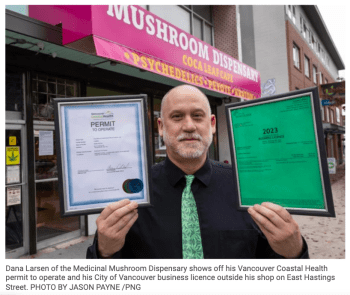
Image #65: https://vancouversun.com/news/crime/why-raid-now-ask-supporters-of-magic-mushroom-shops
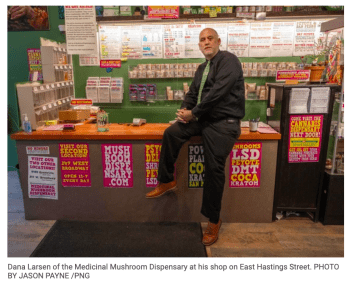
Image #66: https://vancouversun.com/news/crime/why-raid-now-ask-supporters-of-magic-mushroom-shops
Here is a link to some news stories and news video Dana collected from the raid:
https://mushroomdispensary.com/raid-updates/
Raid Pretexts And Raid Reasons, Part 2
Notice in all of the news coverage the only health concerns raised involve nothing worse than “anxiety, fear, nausea and muscle twitches”? Meanwhile people are dying of alcohol and opiate and other hard drug overdoses from drugs that DULF would provide quality-controlled versions of or the Mushroom or Cannabis dispensaries would provide softer substitutes for. Aside from massive – 1000 x regular-sized doses of shrooms or LSD – doses that we don’t supply and that our user guides (40) discourage people from taking – the soft drugs sold at the Mushroom Dispensaries don’t cause any sort of significant health problems – at least none that the police or the politicians bothered to point to. An argument can be made that coffee is the most toxic and most dangerous drug sold at the Café. (41)

Image #67: https://www.cannabisculture.com/blogs/cannabis-vs-caffeine-which-is-safer-a-cup-of-coffee-or-a-puff-of-weed/
So aside from the constant raids against the legacy pot dealers that threaten the corporate pot cartel’s profits (42) and the constant raids on Indigenous pot dealers that threaten the corporate pot cartel’s profits, (43) and aside from the interests of big pharma, who arguably supply “proprietary herbal substitutes” and are threatened by a free market in herbs, (44) and aside from the financial interests of the CIA, who continue to be caught smuggling hard drugs even in the 20th century, (45) what other reason aside from the needs of greedy, powerful people is there for the raids?
Drug War Genocide
The term “genocide” gets used a lot these days, and while an argument can be made that it is used in some cases where it doesn’t apply, I disagree with those who say it’s used far too often. There are many types of genocide at play all over the world – some of which involve mass murder, some of which involve selective murder, and some of which don’t involve any murder whatsoever.
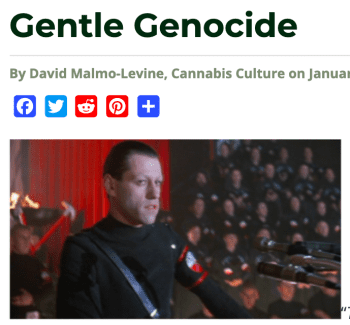
Image #68: https://www.cannabisculture.com/blogs/gentle-genocide/
The term “genocide” originated with a Polish Lawyer named Raphael Lemkin, who wanted to give humans a tool to identify attempts at genocide before they became successful attempts at genocide. The original definition of the term included “forced assimilation” (46) – but that was later transformed into the phrase ““deliberately inflicting on the group conditions of life calculated to bring about its physical destruction in whole or in part.” (47)
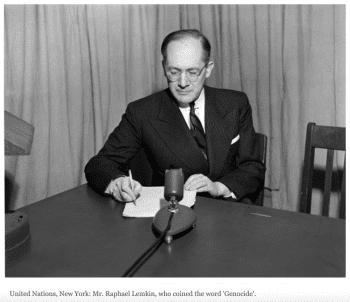
Image #69: https://legal.un.org/avl/ha/cppcg/cppcg.html
That “destruction” might involve the destruction of the people who are targeted for genocide, or it might just involve a characteristic of the targeted group, regardless of whether the target is living or dead. Consider the etymology: ‘Cide’ means to kill, as in homicide or suicide. ‘Genus’ does not mean a large number, but a type or kind. In other words, genocide literally means destroying a characteristic within a type or kind of people – the thing about them that makes them unique – rather than just killing large numbers of people.
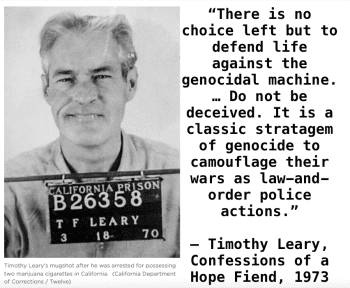
Image #70: https://www.dallasnews.com/arts-entertainment/books/2018/03/26/the-most-dangerous-man-in-america-captures-a-very-trippy-battle-between-richard-nixon-and-timothy-leary/
The characteristic that is targeted in the drug war isn’t the fact that the users, growers and dealers of illegal drugs are drug users, growers and dealers – for there are users, growers and dealers of other drugs who are not persecuted and who remain untargeted. The thing that sets these people apart from the users, growers and dealers of other drugs is that these types are autonomous – they have made decisions based on considerations other than the illegality of the drugs – and thus it is their autonomy that is targeted for elimination, not the drugs they choose, nor the bodies they inhabit.

Image #71: Potshot #15, p. 82 – pot-shot.ca/2017/11/04/issue-15/
If the police somehow became even more powerful than they are today (not an impossibility, given the advances in surveillance and military technology) and succeeded in rounding up each and every drug criminal and gave them a choice between obedience and prison, they wouldn’t need to kill anyone to eliminate the medically autonomous – they would simply dry up the demand and supply for illegal drugs, and eventually achieve 100 percent compliance with the law. The human race would soon forget that disagreeing with politicians was even possible. We would become a race of pets – or livestock.
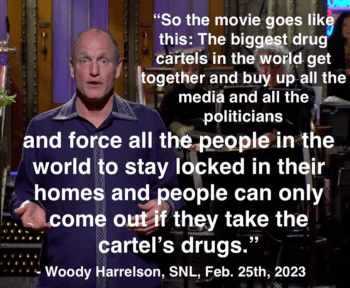
Image #72: Meme by David Malmo-Levine
Some might argue that the intelligence agencies that rely on illegal drug profits to finance their wars, coups and assassinations would never allow the global drug war to get that bad – they don’t want to lose that revenue stream – so there is that side of it, which may account for why the drug war isn’t currently as bad in Vancouver as it is in the Philippines. But one day it could be – if the CIA no longer needs secret wars, assassinations and coups to put the right people into power. If all the right people were successfully placed in power, and election rigging was perfected, then no more secret wars, assassinations and coups would be necessary to run the world. The “final solution” to the “problem” of human autonomy could be put into action.
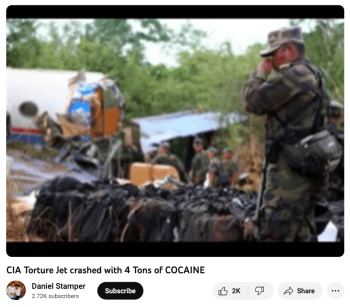
Image #73: “CIA Torture Jet crashed with 4 Tons of COCAINE,” Daniel Stamper https://www.youtube.com/watch?v=oszATUJ4IRE
Genocide is one of the worst evils imaginable. It punishes people – sometimes with death, or incarceration or steep fines some other affront to their dignity – for having an intelligent preference for some drugs over other drugs, for making what could very well be the best (or only) health choices they have available to them, or choosing the most ethical (or only) job option available to them. Even worse, if the genocide of the medically autonomous is successful, the human race becomes more docile, obedient and livestock-like, and the path is paved to make future genocides more likely.
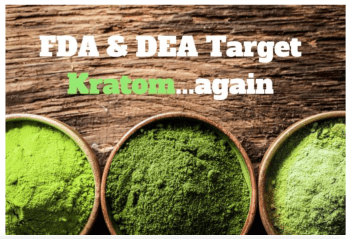
Image #74: https://legislativeanalysis.org/wp-content/uploads/2019/10/Kratom-Fact-Sheet-1.pdf
The FDA sends “warning letters” to kratom retailers claiming there is no “competent and reliable scientific evidence” that kratom can be used to help with withdrawal symptoms, (48) when in fact there’s lots of credible evidence if one bothers to look. If an unaccredited drug store shift supervisor such as this author can find it, what excuse does the FDA have for not finding it? Scapegoaters are incredibly good at not looking for – and/or denying the existence of – any evidence that might make it more difficult for them to scapegoat.
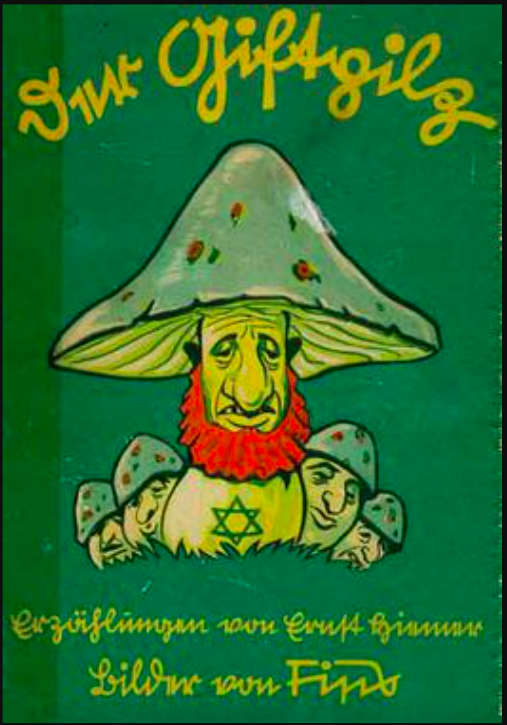
Image #75: https://en.wikipedia.org/wiki/Der_Giftpilz
In 1935, the Nazis produced a children’s textbook about how dangerous Jews were. It was called “The Poisonous Toadstool”. Their intent was to stigmatize the scapegoat to the extent that they were seen as a threat to the community – a threat which required elimination. (49)
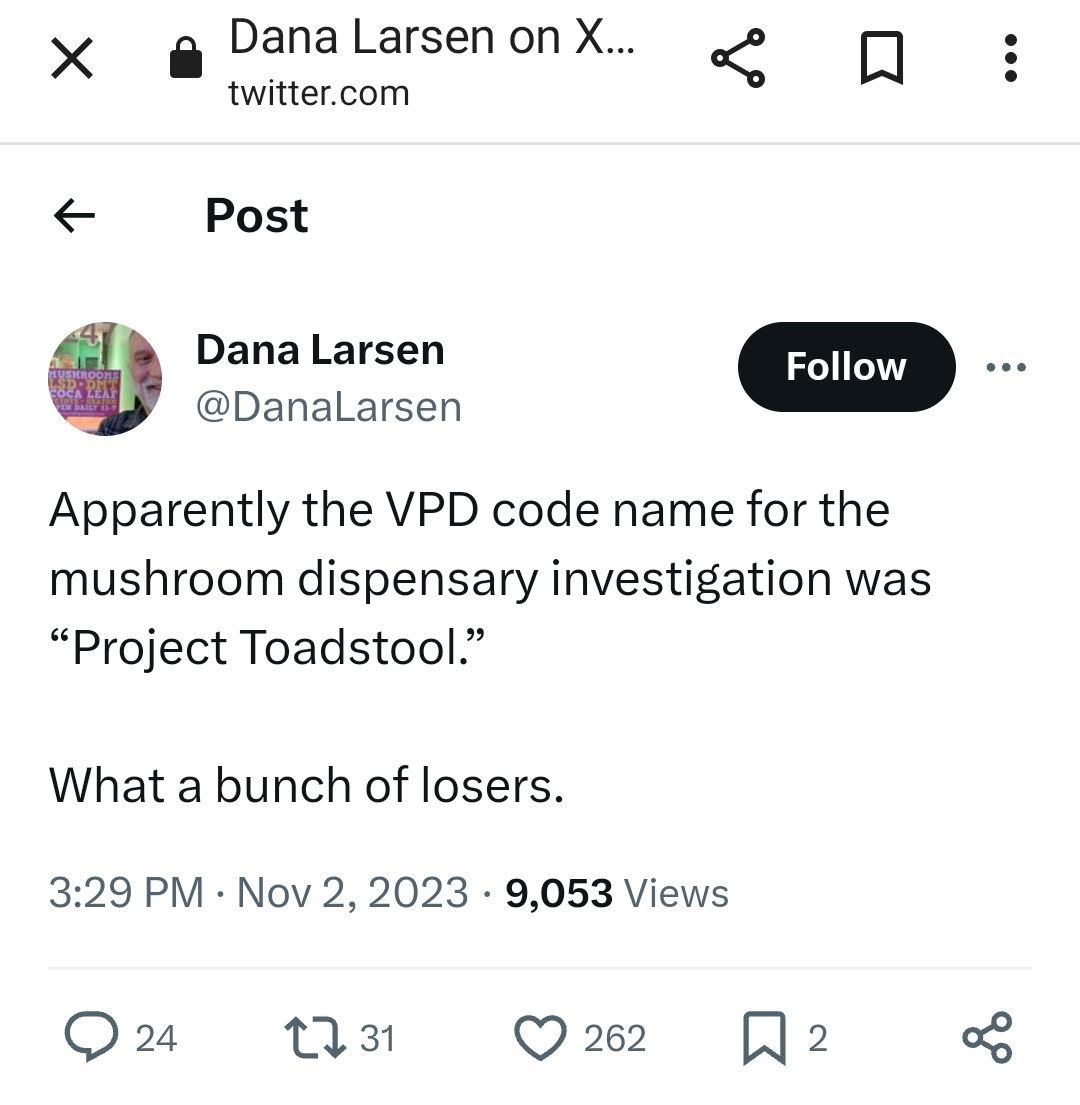
Image #76: https://twitter.com
In 2023, the VPD set in motion “Project Toadstool” – a set of drug raids against drug peace activists in the most liberal and progressive community in North America (in terms of drug policy). Their intent was to stigmatize the scapegoat to the extent that they are seen as a threat to the community – a threat which requires elimination.
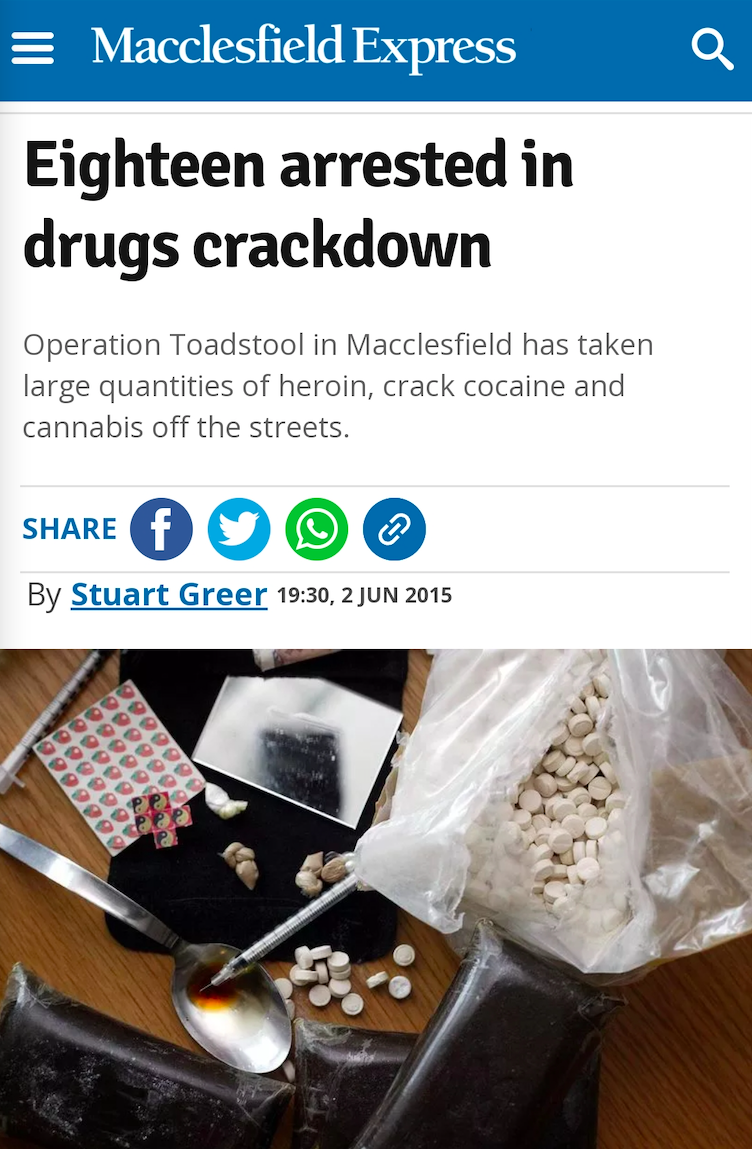
Image #77: https://www.macclesfield-live.co.uk/news/eighteen-arrested-in-drugs-crackdown-9378028
The choice of terminology in both cases reveals both the tactics – and the colossal ignorance – of the scapegoater. A “toadstool” is a term for a mushroom, but – according to Webster’s dictionary – it’s “especially a poisonous or inedible one”. (50) The message from scapegoaters past and present is that the scapegoat is inherently dangerous.

Image #78: “The Experience of Hans and Else with a Strange Man: ‘Here, kid, I have some candy for you. But you have to come with me. . .’,” Der Giftpilz (The Poisonous Toadstool), 1938 https://research.calvin.edu/german-propaganda-archive/thumb.htm
But Jewish people are no more or less dangerous than any other group of people, and the mushrooms and other drugs that are sold at the Mushroom Dispensary are also not dangerous – they didn’t kill anyone, or even cause anyone problems, which is why the police have no problems to point to.

Image #79: “Slyly, Baptiste sold ‘reefers’ to the high school students.” SCIENCE SPEAKS TO YOUNG MEN – ON LIQUOR, TOBACCO, NARCOTICS, and MARIJUANA, By George Thomason, M. D., F. A. C. S., Pacific Press Publishing Association, Mountain View, California, 1938, p. 7
The cops either know this to be true, which makes them genocidal, devious liars (with guns and impunity), or they actually think they’re actually saving people from being poisoned, which makes them a bunch of genocidal morons and idiots (with guns and impunity). Either way, the cops are the inherently dangerous ones, not the activist drug dealers.
In the opinion of this author, the battle for drug peace and drug freedom is a key battle over human evolution itself. For the genocide of the medically autonomous may very well lead to other genocides, while genuine freedom for the medically autonomous may very well lead to other freedoms. Hopefully, we can all learn from past genocides, and avoid repeating them.
What You Can Do
According to the left-leaning Vancouver journalism website The Tyee, DULF is no more. Local hard drug users predict that “it’s just a matter of time before people start dying . . .” (51) Small-scale operations can’t afford lawyers, or the ability to re-stock and fight again.
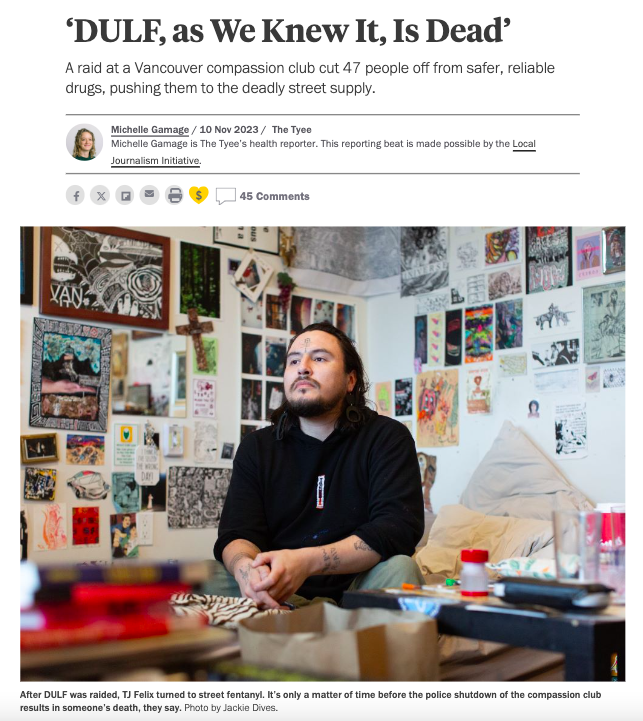
Image #80: https://thetyee.ca/News/2023/11/10/DULF-Compassion-Club-Safer-Drug-Supply-VPD-Raid-Death/
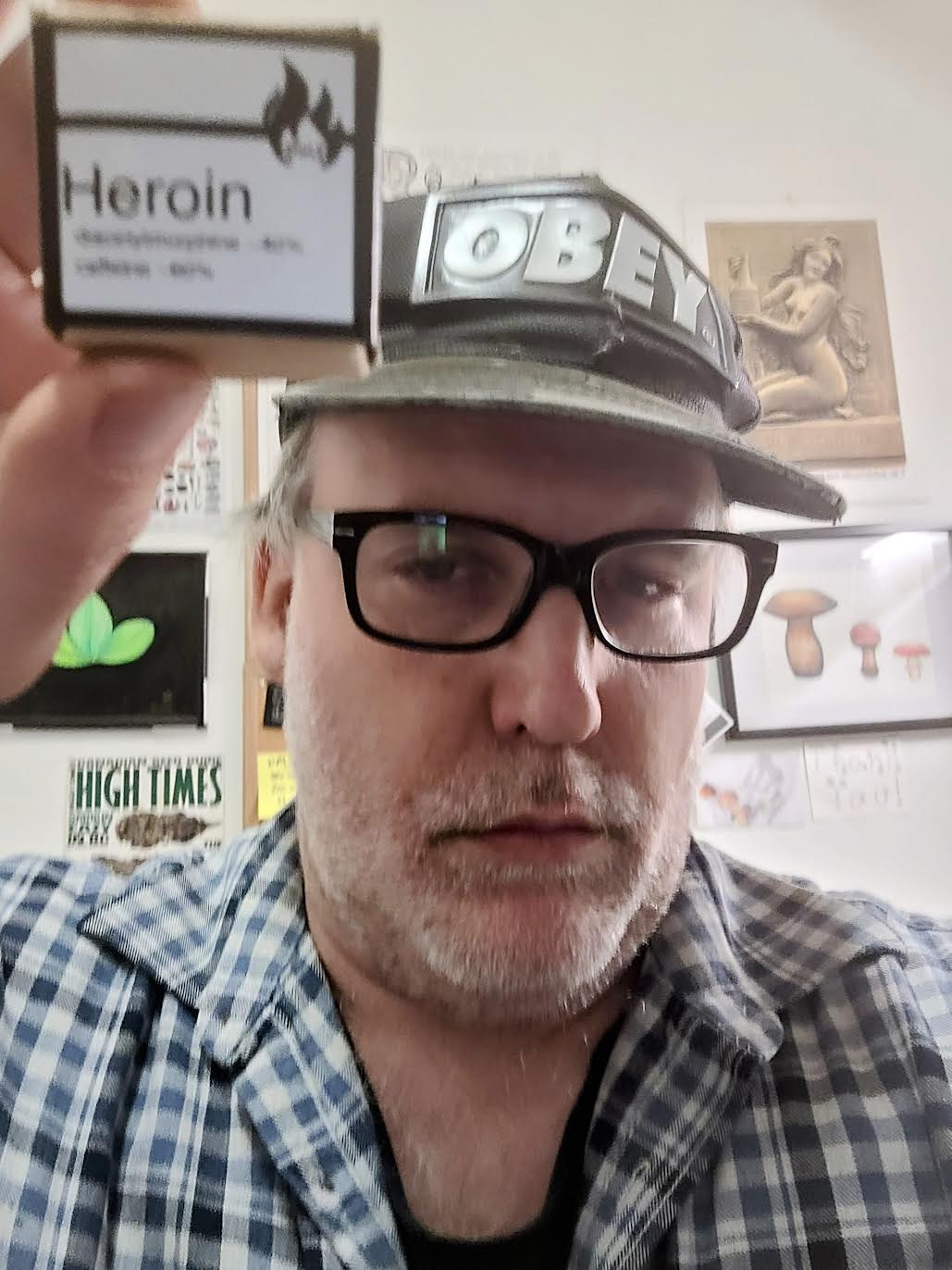
Image #81: Solidarity selfie with DULF package. Photo by David Malmo-Levine
As for the Coca Leaf Café, the cops stole up to 100,000 dollars-worth of illegal drugs, but ended up giving the Mushroom and Cannabis dispensaries millions of dollars-worth of “advertising” – it remains to be seen what the activists can do with all the attention the raids brought us – or if we can survive the economic hit.
The Coca Leaf Café’s business license hearing is at Vancouver City Hall on December 6th, 2023. Contact lawyer Jack Lloyd if you wish to speak at the hearing:
Otherwise, come out in support of the Mushroom Dispensary and the front-line drug peace activists who work there. Maybe if enough people come out and show support, the Mushroom Dispensaries can stay open and continue to supply people with excellent soft drugs, while helping people all over Canada test their drugs, making the illegal drug supply a whole lot safer.
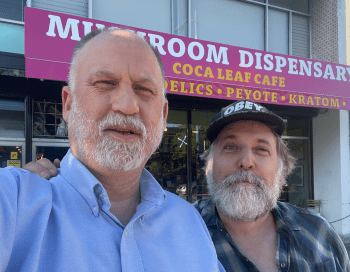
Image #82: https://mushroomdispensary.com
And maybe by joining forces with us you can help us increase public support for the legalization of hard and soft drugs – and even help us prevent the cartelization of the remainder of the illegal soft drugs.
For more information about these drug peace activist groups targeted in the recent raids, check out:
https://mushroomdispensary.com/
https://cannabisdispensary.ca/
https://getyourdrugstested.com/
Post Script:
Just as I was putting the finishing touches on this article, an article was published on the “growopportunity.ca” (pot cartel propaganda funded by the Canadian Government) website on November 10th, 2023, regarding Mark Haden (a foister of stigma upon cannabis) (52) who apparently has “recently began a program giving psychedelics to Vancouver police officers.” (53)
Apparently psychedelics are so dangerous that only millionaires can produce them, (54) only accredited academics can distribute them (55) and only police officers can take them.
Citations:
1. Dana Larsen, “‘Very unexpected’: Vancouver police raid Dana Larsen’s magic mushroom dispensaries,” CTV News, November 1st, 2023 (updated November 2nd, 2023) https://bc.ctvnews.ca/very-unexpected-vancouver-police-raid-dana-larsen-s-magic-mushroom-dispensaries-1.6627117
2. William S. Burroughs, From Gus Van Sant’s Drugstore Cowboy, 1989 (2) adapted from manuscript by James Fogle Drugstore Cowboy: A Novel published 1990
https://beingsakin.wordpress.com/2011/11/13/on-drug-hysteria/
3. https://getyourdrugstested.com/
4. An Urgent Response to a Continuing Crisis, Report to the Chief Coroner of British Columbia, BC Coroners Service Death Review Panel, November 1st, 2023, p. 38
https://www2.gov.bc.ca/assets/gov/birth-adoption-death-marriage-and-divorce/deaths/coroners-service/death-review-panel/an_urgent_response_to_a_continuing_crisis_report.pdf
5. Ibid.
6. “Vancouver police arrest 2 after raids on Drug User Liberation Front – Raids conducted at DULF office in Downtown Eastside, 2 East Vancouver homes,” CBC News, Oct 26, 2023
https://www.cbc.ca/news/canada/british-columbia/drug-user-liberation-front-harm-reduction-vancouver-bc-police-arrests-1.7009019
7. “Chief Coroner Lisa Lapointe provides an update on illicit drug toxicity deaths in the province during a press conference at B.C. Legislature in Victoria, B.C., on Monday, February 24, 2020.”
“B.C. toxic drug deaths ‘largely preventable,’ coroner says, amid push for expanded safer supply access,” November 1, 2023
https://vancouver.citynews.ca/2023/11/01/bc-coroners-service-safer-supply-toxic-drugs/
8. “Michael Egilson, chair of the B.C. Coroners Services’ death review panel, says the quickest way to limit deaths from toxic drugs is to reduce dependence on the unregulated toxic drug supply, by creating access to a quality-controlled, regulated supply of drugs for people at risk.”
https://www.cbc.ca/listen/live-radio/1-46-on-the-coast/clip/16020147-b.c.-coroners-services-argues-expanded-safer-drug-supply
9. “‘Very unexpected’: Vancouver police raid Dana Larsen’s magic mushroom dispensaries,” CTV News, November 1st, 2023 (updated November 2nd, 2023) https://bc.ctvnews.ca/very-unexpected-vancouver-police-raid-dana-larsen-s-magic-mushroom-dispensaries-1.6627117
10. “The Rolleston Committee Report was followed by ‘a period of nearly forty years of tranquility in Britain, known as the Rolleston Era.’”
THE BRITISH EXPERIENCE WITH HEROIN REGULATION, TREVOR BENNETT, Senior Research Associate, Institute of Criminology, Cambridge, England, 1988 https://scholarship.law.duke.edu/cgi/viewcontent.cgi?article=3944&context=lcp
https://en.wikipedia.org/wiki/Rolleston_Committee
11. Practicing Harm Reduction Psychotherapy, An Alternative Approach to Addictions, Patt Denning & Jeannie Little, The Guilford Press, New York, 2012, p. 20
12. “Prescribing heroin – What is the evidence?” Gerry V. Stimson and Nicky Metrebian, Centre for Research on Drugs and Health Behaviour Imperial College St Dunstan’s Road, London, Joseph Rowntree Foundation, 2003
https://www.jrf.org.uk/sites/default/files/jrf/migrated/files/1859350836.pdf
13. “One of the most famous examples of Heroin Assisted Treatment (HAT) came from Dr. John Marks who prescribed diamorphine to 400 patients referred to him by GP’s (Cohen, 1995). Many of Marks’s patients were in employment or training and between 1982 –1995 there were no injection site infections or deaths from overdose and the area as a whole saw a 93% fall in theft and burglary (Hari, 2015). This is furthered by Shaw (2009) who found that after six months of HAT crimes overall fell by 2/3 leading to this form of treatment at £15,000 per year per person to be far cheaper than prison at £44,000. However, sadly in 1995 Mark’s clinic was closed and within 6 months 20 of his patients had died from overdose rising to 41 dead after two years (Hari, 2015).”
Written evidence from Law Enforcement Action Partnership UK (LEAP UK)
https://committees.parliament.uk/writtenevidence/100524/html/
14. “To this day, injectable opiates have continued to be prescribed on a take-home basis in Merseyside.”
HARM Reduction – National and International Perspectives, James A. Inciardi & Lana D. Harrison, editors, Sage Publications, Inc. London, 2000, p. 4
15. “SIH (Supervised Injectable Heroin) is found to be an effective way of treating heroin dependence refractory to standard treatment. SIH may be less safe than MMT (Methadone Maintenance Treatment) and therefore requires more clinical attention to manage greater safety issues. This intensive intervention is for a patient population previously considered unresponsive to treatment. Inclusion of this low-volume, high-intensity treatment can now improve the impact of comprehensive healthcare provision.”
“Heroin on trial: Systematic review and meta-analysis of randomised trials of diamorphine-prescribing as treatment for refractory heroin addiction,” The British Journal of Psychiatry, Volume 207, Issue 1, July 2015, pp. 5 – 14
https://www.cambridge.org/core/journals/the-british-journal-of-psychiatry/article/heroin-on-trial-systematic-review-and-metaanalysis-of-randomised-trials-of-diamorphineprescribing-as-treatment-for-refractory-heroin-addiction/A3C4F1D0F709099E47472B42507FF97C
16. “In 2009, the Injectable Opiate Treatment Expert Group considered the available evidence on the effectiveness and cost-effectiveness of HAT. It recommended that this treatment be expanded to cover a larger proportion of the minority of opioid-dependent persons who need this treatment. It also noted that central funding and coordination would be necessary to support the availability of this treatment (Injectable Opioid Treatment Expert Group, 2009). Despite this advice, central funding for HAT in England was ended in 2015. This funding was not replaced at local level and the three clinics that were providing HAT closed down.”
“Reducing Opioid-Related Deaths in the UK,” ACMD (Advisory Council on the Misuse of Drugs), December, 2016
https://assets.publishing.service.gov.uk/government/uploads/system/uploads/attachment_data/file/576560/ACMD-Drug-Related-Deaths-Report-161212.pdf
https://committees.parliament.uk/writtenevidence/100524/pdf/
17. “The case for prescription heroin”, Johann Hari, The Spectator, May 2015 https://life.spectator.co.uk/articles/the-case-for-prescription-heroin/
18. https://en.wikipedia.org/wiki/Heroin-assisted_treatment
19. “The case for prescription heroin Vancouver gives heroin to people suffering from addiction — and it works.” Jun 12, 2017
https://www.vox.com/policy-and-politics/2017/6/12/15301458/canada-prescription-heroin-opioid-addiction
20. https://www.dulf.ca/
21. https://cocaleafcafe.com/about-coca/
22. “Since 1984 I have recommended the chewing of the coca leaf, between 100 to 200 grams of coca leaf per week for the treatment of cocaine dependence. Since this treatment was dispensed on an ad hoc basis, it was not possible to measure the relapses. However, an assessment was conducted on the basis of mental condition and level of social and economic adaptation before and after treatment. The patent’s level of social acceptance, before treatment, only reached 60% at most, and after treatment, 26% improved their level of adaptation. Four patients among 50 reached an adaptation level of 100%. Upon final assessment, the level of social adaptation prior to treatment was only 28%, after treatment as many as 48.8% of the patients were socially adapted.”
“Coca leaf chewing as therapy for cocaine maintenance,” November 2000, Annales de Medecine Interne 151 Suppl B:B44-8
https://www.tni.org/files/publication-downloads/coca-leaf-cocaine-maintenance.pdf
23. “Professor Probes Psychedelic Drugs for a Cure to Nicotine Addiction,” January 7, 2014
https://www.washingtonian.com/2014/01/07/professor-probes-psychedelic-drugs-for-a-cure-to-nicotine-addiction/
24. “Lyophilized Kratom Tea as a Therapeutic Option for Opioid Dependence,” Drug and Alcohol Dependence, Volume 216, 1 November 2020, 108310
https://www.kslegislature.org/li/b2023_24/committees/ctte_h_fed_st_1/documents/testimony/20230201_13.pdf
25. “Mitragyna speciosa as a Potential Substitute Therapy in Opioid Dependence: A Case Report,” Karniza Khalid1, Jason S.K. Wong, Ruzita Jamaluddin, Pharmaceutical Sciences and Research (PSR), 9(1), 2022, 1 – 6 https://scholarhub.ui.ac.id/cgi/viewcontent.cgi?article=1215&context=psr
26. “Kratom use and mental health: A systematic review,” Marc T. Swogger, Zach Walsh, Drug and Alcohol Dependence, Volume 183, 1 February 2018, Pages 134-140
https://www.sciencedirect.com/science/article/abs/pii/S0376871617305586
27. “Study Pokes Holes in Kratom’s ‘Bad Rap’,” Dec. 13, 2017
https://www.urmc.rochester.edu/news/story/study-pokes-holes-in-kratoms-bad-rap
28. “Kratom Use Within the Context of the Evolving Opioid Crisis and the COVID-19 Pandemic in the United States,” Walter C. Prozialeck, Peter C. Lamar, Michael Krupp, Matthew Moon, Laura E. Phelps, Oliver Grundmann, PERSPECTIVE article Front. Pharmacol., 26 August 2021 Sec. Ethnopharmacology Volume 12 – 2021 https://www.frontiersin.org/articles/10.3389/fphar.2021.729220/full
29. https://takiwasi.com/en/investiga04.php
30. “Ayahuasca and the treatment of addiction,” Mana vol.19 no.3 Rio de Janeiro Dec. 2013.
by Marcelo S. Mercante, Ph. D. (translated by Ati Supino, Ph. D.)
https://www.takiwasi.com/docs/arti_ing/ayahuasca-treatment-addiction.pdf
31. “Classic hallucinogens in the treatment of addictions,” Michael P. Bogenschutz, Matthew W. Johnson, Progress in Neuro-Psychopharmacology & Biological Psychiatry 64 (2016) 250-258
https://soultribes.org/wp-content/uploads/2023/06/Bogenschutz2016-Classic_hallucinogens_in_the_treatment_of_addictions.pdf
32. “Mini-review: The neurobiology of treating substance use disorders with classical psychedelics,” Marvin M. Urban, Moritz R. Stingl, Marcus W. Meinhardt, Front. Neurosci., 17 April 2023 Sec. Neuropharmacology Volume 17 – 2023
https://www.frontiersin.org/articles/10.3389/fnins.2023.1156319/full
33. “Based upon a review of the literature, it is concluded that further research into LSD’s potential as a treatment for addictions is warranted.”
“A review of lysergic acid diethylamide (LSD) in the treatment of addictions: historical perspectives and future prospects,” Mitchell B Liester, Curr Drug Abuse Rev . 2014;7(3):146-56.
https://pubmed.ncbi.nlm.nih.gov/25563445/
34. “First, well-designed and adequately powered efficacy trials should be conducted testing the efficacy of classic hallucinogens (particularly psilocybin and LSD) for the indications where the existing evidence strongly suggests efficacy: addiction to drugs including alcohol and nicotine, and existential crisis in the face of death among cancer patients or in other patients facing life-threatening illness. Phase II trials for psilocybin-assisted psychotherapy for cancer-related psychological distress were recently completed and a phase III trial for this same indication is currently being planned which potentially could lead to the historic partial rescheduling of psilocybin to become a prescribable medication. Furthermore, controlled trials are already under way testing the efficacy of psilocybin in the treatment of alcohol use disorders, tobacco addiction, and cocaine addiction. Second, a broader range of classic hallucinogens and possible indications should be studied. The encouraging results that have been seen with classic hallucinogen treatment across alcohol, nicotine, and opioid dependence suggest the possibility that other chemical and behavioral addictions may also respond to treatment with these agents.”
“Therapeutic Applications of Classic Hallucinogens,” Michael P. Bogenschutz and Stephen Ross, Springer-Verlag Berlin Heidelberg 2016 Curr Topics Behav Neurosci, p. 23
https://web.archive.org/web/20190302134625id_/http://pdfs.semanticscholar.org/b68e/68b5d5bf010dbc8b84040457077b456871d5.pdf
35. “Study participants described using cannabis as a safer alternative for alcohol, illicit drugs and pharmaceuticals based on their perceptions of less adverse side effects, low-risk for addiction and greater effectiveness at relieving symptoms, such as chronic pain.”
“A safer alternative: Cannabis substitution as harm reduction,” Nicholas Lau, Paloma Sales, Sheigla Averill, Fiona Murphy, Sye-Ok Sato, Sheigla Murphy, Drug Alcohol Rev . 2015 Nov;34(6):654-9.
https://pubmed.ncbi.nlm.nih.gov/25919477/
“Cannabis is perceived to be an effective treatment for diverse conditions, with pain and mental health the most prominent. Findings include high self-reported use of cannabis as a substitute for prescription drugs (63%), particularly pharmaceutical opioids (30%), benzodiazepines (16%), and antidepressants (12%). Patients also reported substituting cannabis for alcohol (25%), cigarettes/tobacco (12%), and illicit drugs (3%).”
“Medical cannabis access, use, and substitution for prescription opioids and other substances: A survey of authorized medical cannabis patients,” Philippe Lucasa, Zach Walsh, International Journal of Drug Policy, 42 (2017) 30-35
https://greenleafmc.ca/wp-content/uploads/2019/02/Cannabis-as-a-substitute-for-opioids-and-other-substances-2017.pdf
“This article presents results that confirm previous clinical studies suggesting that cannabis may be an effective analgesic and potential opioid substitute. Participants reported improved pain, health, and fewer side effects as rationale for substituting.”
“Pills to Pot: Observational Analyses of Cannabis Substitution Among Medical Cannabis Users With Chronic Pain,” Kevin F. Boehnke, J. Ryan Scott, Evangelos Litinas, Suzanne Sisley, David A. Williams, and Daniel J. Clauw, The Journal of Pain, Vol 20, No 7 (July), 2019: pp 830−841
https://www.jpain.org/article/S1526-5900(18)30735-1/pdf
36. https://norml.org/marijuana/fact-sheets/relationship-between-marijuana-and-opioids/
37. Dana Larsen, “‘Very unexpected’: Vancouver police raid Dana Larsen’s magic mushroom dispensaries,” CTV News, November 1st, 2023 (updated November 2nd, 2023)
https://bc.ctvnews.ca/very-unexpected-vancouver-police-raid-dana-larsen-s-magic-mushroom-dispensaries-1.6627117
38. “Magic mushroom dispensaries raided, owner arrested as Vancouver Police pivot focus from street drugs,” NOVEMBER 2, 2023 UPDATED NOVEMBER 3, 2023
https://www.theglobeandmail.com/canada/article-magic-mushroom-dispensaries-raided-owner-arrested-as-vancouver-police/
39. “Why raid now, ask supporters of magic mushroom shops,” November 5th, 2023
https://www.msn.com/en-ca/health/other/why-raid-now-ask-supporters-of-magic-mushroom-shops/ar-AA1jnL8L
40. https://mushroomdispensary.com/userguide/
42. https://www.cannabisculture.com/blogs/the-raid-lobby/
43. https://www.cannabisculture.com/blogs/traditional-medicine/
44. https://www.cannabisculture.com/blogs/medical-monopoly-works/
https://www.cannabisculture.com/blogs/covid-19-cannabis-herbal-medicine/
https://www.cannabisculture.com/blogs/covid-19-cannabis-herbal-medicine-part-2-gain-of-function/
https://en.wikipedia.org/wiki/Herbal_medicine
https://www.cannabisculture.com/blogs/legalize-shrooms/
https://www.cannabisculture.com/blogs/the-amazing-world-of-the-coca-leaf/
45. Cocaine-laden plane crashes in Mexico jungle https://www.reuters.com/article/us-mexico-drugs-idUSN2435638420070924
A Mexican plane crash, the CIA, and 3.3 tons of cocaine What’s the link between a plane crash landing in Mexico, the CIA and 3.3 tons of cocaine?, asks Jeff Sparrow. https://www.crikey.com.au/2008/09/08/a-mexican-plane-crash-the-cia-and-33-tons-of-cocaine/
Mexico Drug Plane Used for US ‘Rendition’ Flights: Report https://www.banderasnews.com/0809/nr-renditionflights.htm
CIA Torture Jet wrecks with 4 Tons of COCAINE https://www.dailykos.com/stories/2007/12/12/420107/-CIA-Torture-Jet-wrecks-with-4-Tons-of-COCAINE
2007 Yucatan Gulfstream drug crash https://wikispooks.com/wiki/2007_Yucatan_Gulfstream_drug_crash
Six years on: The mysterious crash of Cocaine2
https://www.madcowprod.com/2013/09/27/six-years-on-the-mysterious-crash-of-cocaine2/
46. The Genocide Convention: An International Law Analysis By John B. Quigley, Ashgate Publishing, Burlington, VT, 2006, p. 9, quoted in “Gentle Genocide”, David Malmo-Levine, Cannabis Culture, January 13, 2010 https://www.cannabisculture.com/blogs/gentle-genocide/
47. http://www.preventgenocide.org/genocide/officialtext-printerfriendly.htm
48. WARNING LETTER Kratom Exchange MARCS-CMS 633972 — JUNE 30, 2022 https://www.fda.gov/inspections-compliance-enforcement-and-criminal-investigations/warning-letters/kratom-exchange-633972-06302022
49. “Der Giftpilz (The Poisonous Mushroom) is a piece of antisemitic Nazi propaganda published as a children’s book by Julius Streicher in 1938. The title is German for ‘the poisonous mushroom/toadstool’.”
https://en.wikipedia.org/wiki/Der_Giftpilz
50. https://www.merriam-webster.com/dictionary/toadstool
51. “‘DULF, as We Knew It, Is Dead’ – A raid at a Vancouver compassion club cut 47 people off from safer, reliable drugs, pushing them to the deadly street supply.” Michelle Gamage, 10 Nov 2023 https://thetyee.ca/News/2023/11/10/DULF-Compassion-Club-Safer-Drug-Supply-VPD-Raid-Death/
52. “Stigma-Foisters part 1: Mark Haden,” David Malmo-Levine, December 1, 2017 https://www.cannabisculture.com/blogs/stigma-foisters-part-1-mark-haden/
53. “Mark Haden, who served as the executive director of MAPS Canada for 10 years and is currently the clinical supervisor for the Psychedelic Treatment Program at QI Integrated Health as well as the VP of business development at Clearmind Medicine, recently began a program giving psychedelics to Vancouver police officers.”
“Mark Haden and Gabor Maté talk the bright side of psychedelics – Spirit Plant Medicine Conference is an annual gathering at UBC’s Vancouver campus that offers a space for cultural exploration, spiritual insight and personal growth,” November 10, 2023
https://www.growopportunity.ca/mark-haden-and-gabor-mate-talk-the-bright-side-of-psychedelics/
54. “B.C.-based company Optimi Health has harvested its first cultivation of psilocybin mushrooms at its Health Canada-licensed facilities in Princeton, B.C., positioning itself as a major player in the burgeoning psychedelic sector. The $14-million venture consists of two 10,000-square-feet facilities with a combined total of 10 growing rooms that can produce approximately 2,000 kilograms of dried psilocybin mushrooms a month, according to Optimi’s head cultivator, Todd Henderson.”
“B.C. company opens Canada’s largest licensed psychedelic mushroom growing facility – Optimi Health set to produce 2,000 kilograms of dried psilocybin mushrooms a month in its Princeton facilities,” Brady Strachan · CBC News · May 28, 2022 https://www.cbc.ca/news/canada/british-columbia/psychedelic-mushrooms-psilocybin-health-canada-clinical-trials-1.6469310
55. “Vice President of Business Development – Clearmind Medicine” https://markhaden.com/?page_id=7
“IP portfolio of 31 patent filings . . . 6 families for combinations of PEA with: MDMA, ibogaine, ketamine, LSD, psilocybin and DMT . . .” https://www.clearmindmedicine.com/science-and-ip


